Last updated: April 2023
SERVICES
I-TIP Services: User Guide
1. What is I-TIP services?
I-TIP Services, the services component of the Integrated Trade Intelligence Portal (I-TIP), consists of four modules providing information on:
- Members' commitments and MFN exemptions under the WTO's General Agreement on Trade in Services (GATS), as well as market access preferences for least-developed countries granted by Members under the LDC Services Waiver;
- Services commitments in regional trade agreements notified to the WTO (RTAs);
- Applied measures affecting access to and operations in economies' services markets, as well as Services Trade Restrictions Indices (STRIs); and
- Relevant services statistics.
The main objective of the integrated database is to make it easier for Members and other stakeholders to access the various types of information relevant for services trade policy-making. It is the only database providing such scope of information on trade in services.
1.1 Module on GATS
The module on “GATS” (herein referred to as GATS module) contains all the specific commitments and exemptions to the obligation of most-favoured-nation treatment (MFN) undertaken by WTO Members under the GATS. Additional information on the GATS, in particular as regards the scheduling of commitments and related concepts, can be found on this page.
The GATS module also includes the preferential market access commitments for least-developed countries granted by WTO Members under the LDC Services Waiver. The list of notifying Members is available from the I-TIP Services portal.
1.2 Module on RTA Commitments
The RTA module allows users to access and search for information on commitments in regional trade agreements notified under Article V of the GATS. The list of RTAs covered is available from the I-TIP Services portal.
1.3 Module “Services Trade Policy Database”
The Services Trade Policy Database provides information on applied measures affecting access to markets and conditions of operation of foreign service suppliers. Additional information on measures is continuously being added.
The Services Trade Policy Database module provides information jointly compiled by the World Bank and the WTO. Information is available for 129 economies. For 87 of these economies, the information was collected through a survey conducted jointly by the World Bank and WTO, with the support of ITC, the CEFTA Secretariat, GiZ and EU. The information for 43 economies was sourced from the OECD STRI regulatory database (2016 vintage), thanks to the co-operation of the OECD, which is gratefully acknowledged.
The module also includes indices quantifying the level of restrictiveness of services trade policies.
Additional information from other WTO sources and other useful sources of information on applied policies are also provided (e.g. WTO DG monitoring reports, trade policy reviews).
1.4 Module on Statistics
The module on services statistics presents available information on economies' balance of payments services trade flows (by service sectors and, when possible, by partner), statistics on foreign establishment of firms (activities of foreign affiliates and foreign direct investment in service industries), as well as market information (production, employment and sector-specific monetary and non-monetary indicators). This information is provided in a standardized format for all economies.
back to top
2. How to use the application
2.1 General information
2.1.1 Home page
The home page, or portal, contains four rectangular icons, one for each of the four modules. By clicking on the relevant icon, the user can access the corresponding selection page for each module.
After having acceded to a module, the user can easily move to another one without having to go back to the entry page. This can be done by clicking on the relevant module from the 'menu banner' at the top of the page. Clicking on the ![]() icon at the top right-hand side of the page from anywhere in the application allows the user to go back to the home page.
icon at the top right-hand side of the page from anywhere in the application allows the user to go back to the home page.
The portal also provides links to some important documents (Services Sectoral Classification List(1), Guidelines to the scheduling of commitments under the GATS(2)), as well as links to relevant websites such as the Services gateway page, the Air Services Agreement Projector (ASAP), and the WTO RTA Database.
A disclaimer also appears at the bottom of the page.
An e-mail address is provided to allow users to ask questions and provide comments.
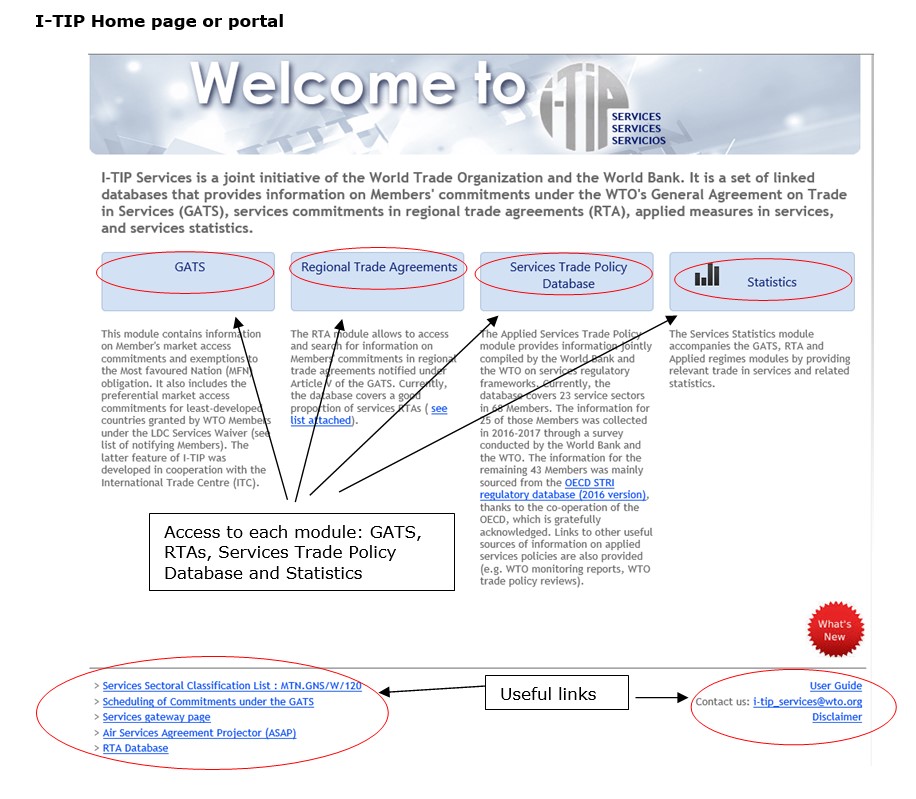
2.1.2 Sector Classification
All modules permit selection by services sectors or subsectors. The common sector classification used is that of the Services Sectoral Classification List (MTN.GNS/W/120), which was developed by the WTO Secretariat during the Uruguay Round. Although not mandatory, it has been used by most Members for scheduling their GATS commitments. The complete list can be consulted through the following link(3).
The user can choose the sectors or subsector at different levels of aggregation by clicking on the arrow next to a sector group which will display or hide the components of the sector group.
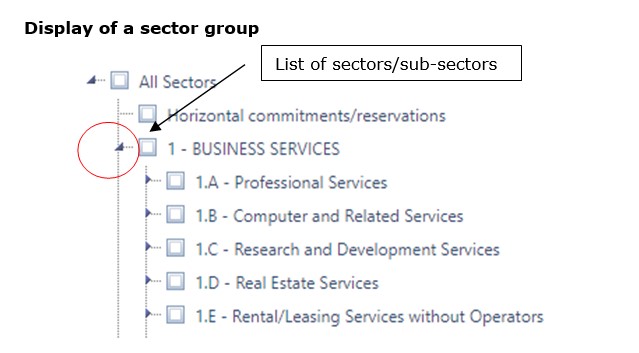
2.1.3 Economies and economic/regional groupings
All modules permit selection of economies individually, as well as according to different selected groupings (region, sub-region, selected trading groups, acceded WTO Members and least developed countries).
The selection of an economy can be done by checking the box next to its name. To facilitate the selection, the name of an economy can also be typed in the corresponding space at the top of the drop-down menu.
In order to visualize the selection by group, the user needs to scroll down the selection drop-down menu, or click on “Show group” at the top left-hand side of the drop-down menu list.
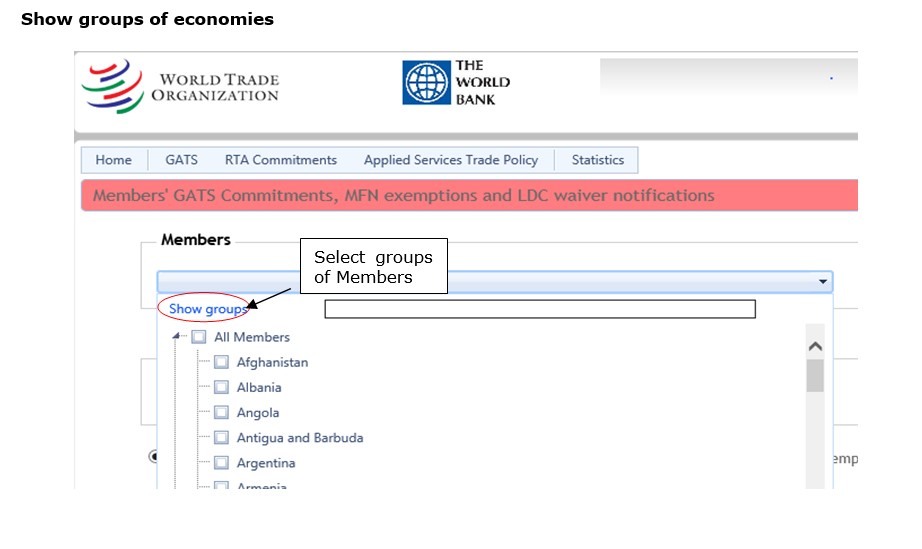
2.1.4 Language
The interface of I-TIP Services, as well as the information it contains, is available only in English. The only exception relates to data on services commitments in regional trade agreements (RTAs), where information in Spanish is included for RTAs whose texts are only available in that language.
2.1.5 Navigating across modules
The user can select a module by clicking on the relevant icon on the I-TIP Services home page.
At the top of all pages a menu bar is shown, containing command buttons for Home, and the four different modules in the database. There is also a link to the User Guide on the right-hand side. This menu bar is available throughout the application. When navigating from one module to the other, selected economies and sectors are retained. This means, for example, that the user can easily switch from looking at Albania's GATS commitments on Communication Services, to the available information on this Member's applied services trade policy in the selected sector. Switching to the RTA module will send you to the “search criteria” page of that module, as the RTAs for which the user wants to view the commitments also need to be selected.
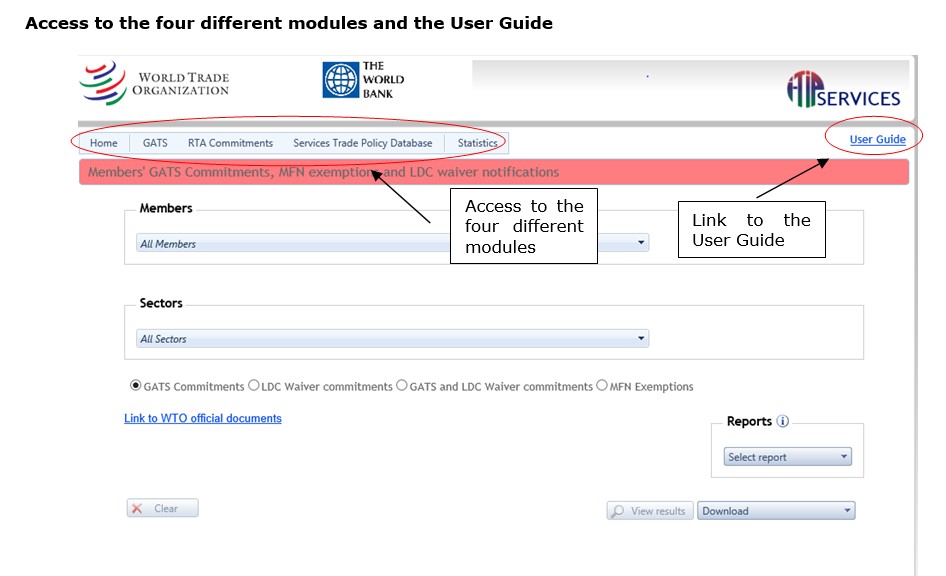
back to top
3. GATS Module
This module contains the GATS commitments and MFN exemptions undertaken by WTO Members currently in force. It also includes the preferential market access commitments for least-developed countries granted by WTO Members under the LDC Services Waiver.
For the purposes of this module, the electronic versions of the specific commitments listed in schedules and MFN exemptions have been consolidated. The information is therefore more easily accessible than in the paper/treaty copies, where commitments and MFN exemptions of individual Members may appear in different documents due to successive negotiations. For more information on the GATS, please visit these two links:
- The General Agreement on Trade in Services: An Introduction
- The General Agreement on Trade in Services (GATS): objectives, coverage and disciplines
For more information on the GATS schedules of commitments and MFN exemptions, please refer to the Guidelines for Scheduling of Specific Commitments under the GATS, adopted by the Council for Trade in Services on 23 March 2001 (document S/L/92), which can be directly accessed by clicking on “Scheduling of Commitments under the GATS” in the main page of I-TIP Services.
In this module, only the LDC services waiver entries that differ from the consolidated list of GATS commitments are published (i.e. to ease the relevance and comparability of information notified by various Members. The entries that are identical to the GATS commitments have not been included in I-TIP Services). For more information on the LDC Services Waiver, please see here.
3.1 Differences between the original versions and the I-TIP Services electronic versions of the schedules, lists of MFN exemptions and LDC services waiver notifications
The electronic version of the commitments and exemptions contained in this module has no legal value. Only the treaty copies are authentic.
In order to allow I-TIP users to perform structured searches, and in particular to present the information in a standardised way, several adjustments have been made to the presentation of the original schedules.
In the original schedule, the text describing sectors and subsectors is shown in the sector column, in the same row as the market access and national treatment limitations, and additional commitments. In I-TIP this text is presented in a row above those entries. Also, italics and underlines in the original documents are not reproduced. Further, the alignment of text was also modified in some cases.
Finally, as indicated in the previous section, to ease the relevance and comparability of information notified by various Members on preferences accorded to LDCs (i.e. under the Services Waiver). the entries that are identical to the GATS commitments have not been included in I-TIP.
3.2 Schedule and list of MFN exemptions for the European Union
The schedule of specific commitments currently in force for the European Union is that of the EU-25, that is including those that were members of the Union in 2006: Austria, Belgium, Cyprus, Czech Republic, Denmark, Estonia, Finland, France, Germany, Greece, Hungary, Ireland, Italy, Latvia, Lithuania, Luxembourg, Malta, Netherlands, Poland, Portugal, Slovak Republic, Slovenia, Spain, Sweden and United Kingdom. The MFN exemption lists currently in force are those of EC12 and the 13 other EU25 members. The MFN exemption list shown in I-TIP for EU25 is therefore a consolidation of the EC12 and the 13 other EU-25 members lists of MFN exemptions.
Selecting one of the 25 EU members listed above will take you directly to the I-TIP schedule of specific commitments or list of MFN exemption lists of the EU25.
The commitments and exemptions in force for Bulgaria, Romania and Croatia continue to be shown separately in I-TIP as these correspond to the bindings currently in force for these Members.
How to use the GATS module
3.3.1 Making a selection
After clicking on the “GATS” icon on the I-TIP Services portal, a page with a red banner appears, and offers the possibility to search across schedules of commitments, MFN exemptions or LDC waiver commitments by selecting WTO Member(s) and service sectors.
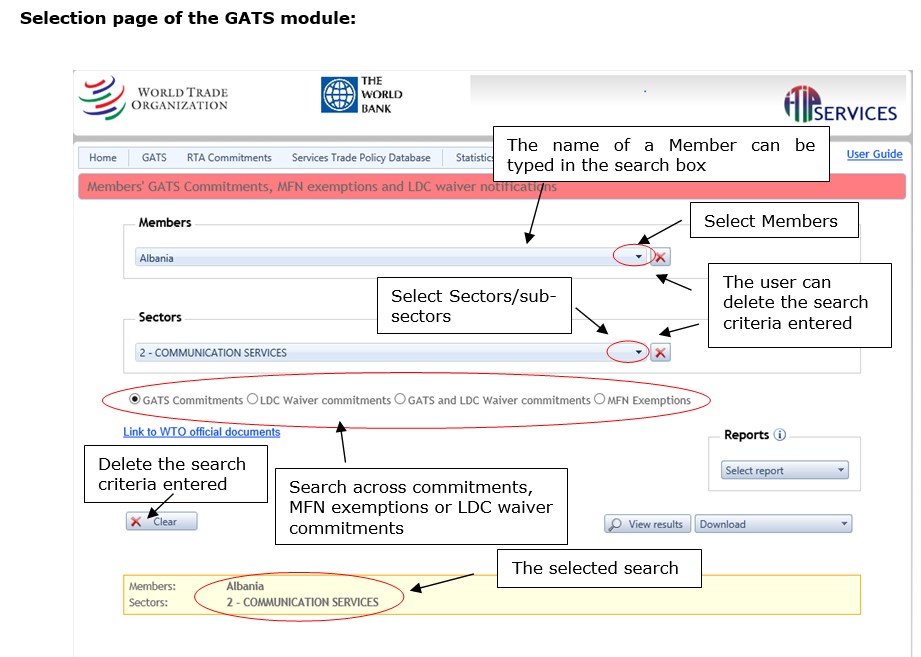
The drop-down list for the “Members” search criteria permits to select one, many Members or groups of Members (see section 2.1.3).
It is also possible to limit the search to one or more service sectors, sub-sectors, or horizontal commitments (see section 2.1.2).
The selected criteria appear at the bottom of the screen (in a yellow banner). To delete these criteria, click on the red “X” next to the drop-down lists for Members and Sectors (for selective deletion) or on the “X clear” button (to delete all search criteria).
To view the results, press the “view results” button.
From the selection screen, it is also possible to download directly the selected information into Excel, csv or pdf formats (see dropdown menu “Download” at the bottom left-hand side of the screen). A bulk download facility for all the information (i.e. “All Members, All sectors”) is also available (csv format). A description of the Excel and csv files is provided in section 3.3.6.
Finally, summary reports can be accessed directly from the selection page (see section 3.3.4 for a description of the GATS summary reports).
3.3.2 Link to WTO documents
A direct link to the official WTO documents containing schedules of specific commitments, lists of MFN exemptions and LDC waiver notifications is provided from the search page by clicking on “Link to WTO official documents”. If you are visualizing “commitments”, clicking the link will open a new tab, entitled “WTO Documents”.
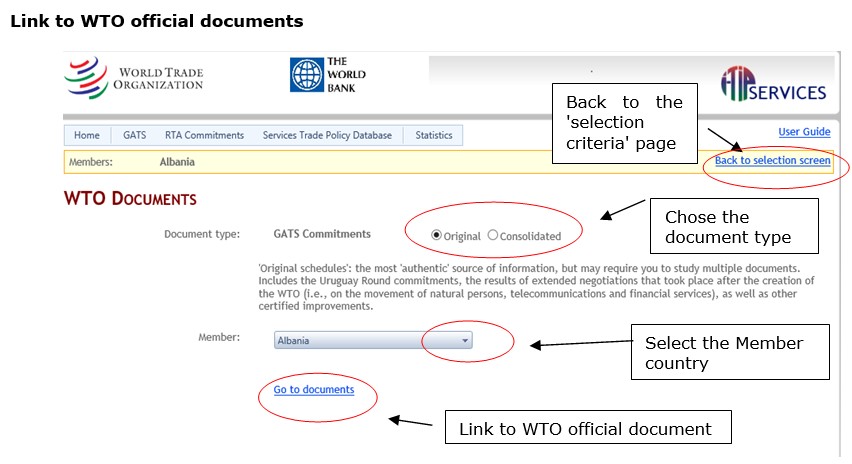
Select the document type in the case of specific commitments (‘original’ or ‘consolidated’'), select a Member from the drop-down list, and then click on “Go to Documents”. This will bring your selection directly through the WTO document search facility. Mutatis mutandis, the same procedure applies if you want to visualize MFN exemptions or the LDC waiver notifications.
3.3.3 Overview of selection results
3.3.3.1 Main features
The results of the selection defined by the user are first presented in an overview page. An example is provided below.
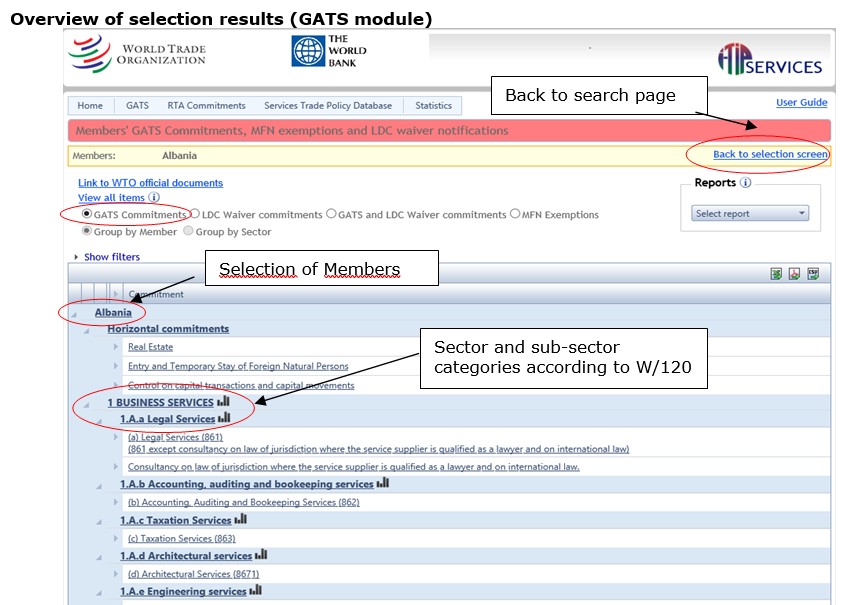
Below the menu bar, the selection criteria are presented. Clicking on “back to selection screen” sends the user back to the search page of the module being used, where new criteria can be entered to perform a new selection.
The results are presented in the table. In order to visualize the information on MFN exemptions (if any) or the LDC waiver commitments, the relevant radio button should be selected. By default, the results are ordered by Member, then by sector and subsector (following the order in WTO document W/120).
The text in the commitment column is the text that appears in the sector column of Members' GATS or LDC waiver commitments, or alternatively MFN exemptions lists. The table indicates the services in which specific commitments have been made under each sector group of the classification.
If a sector group or sub-group does not appear in this page, it means that the Member has not undertaken commitments or listed MFN exemptions in that sector or sub-sector.(4)
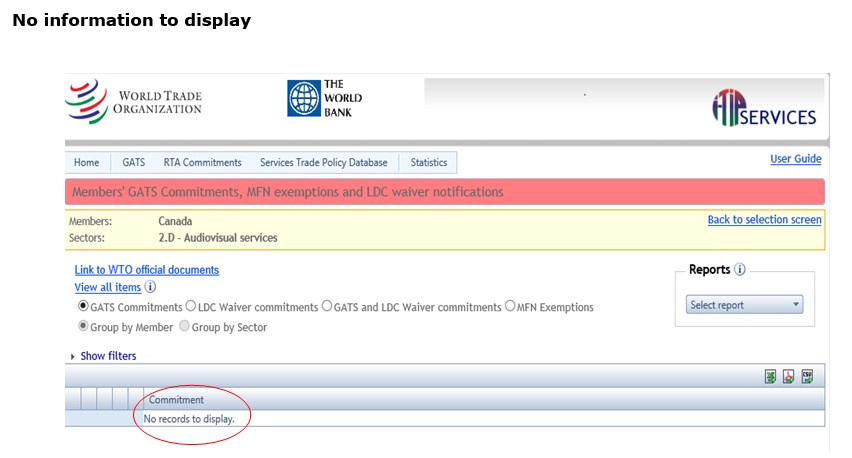
LDC waiver preferences are highlighted in red in order to clearly identify those when viewing them with the GATS specific commitments.
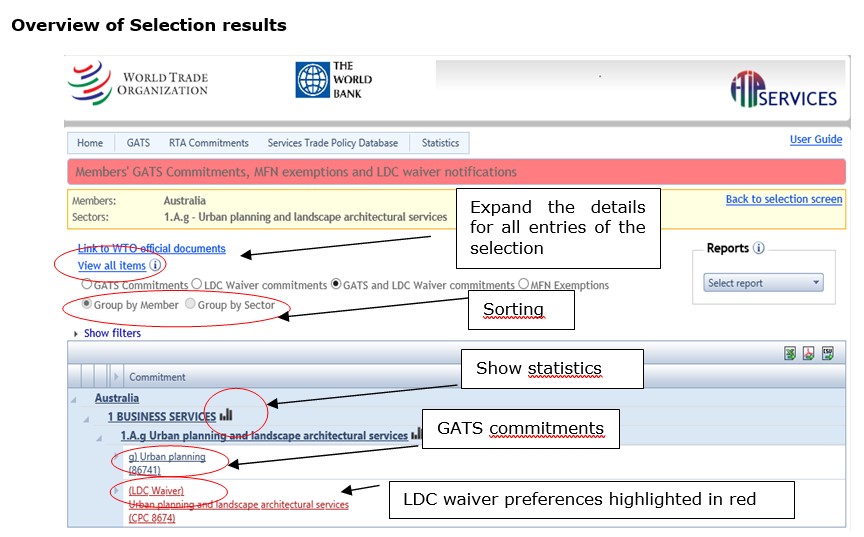
The user can navigate to different pages of the selection results by using the relevant page number links at the bottom of the table. The number of records to be displayed on a single page (10, 20, 50, 100, All records) may be defined by the user by clicking on the drop-down menu on “page size”. By clicking on the “View all items” hyperlink at the top left-hand side of the result screen will expand the details for all entries of the selection, concatenating all results on a single page.
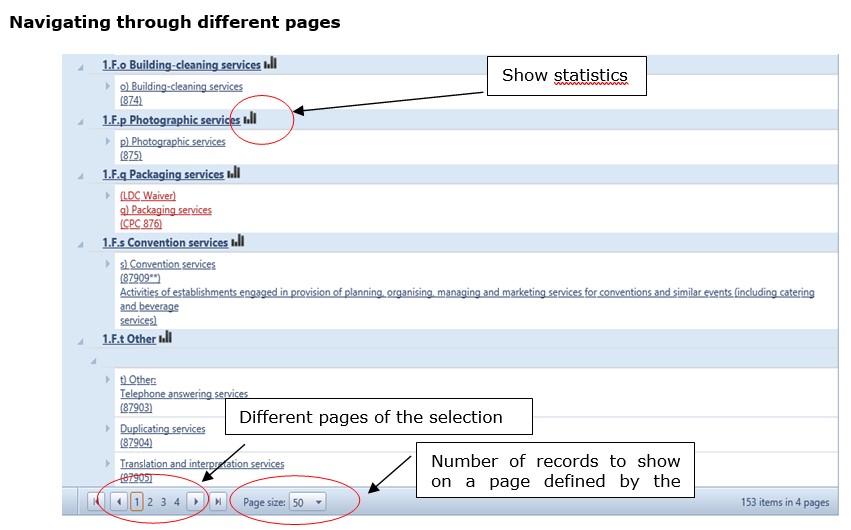
To print the search results as displayed on the page, the print function of the browser can be used.
In the GATS/LDC waiver commitments pages, clicking on the “bar chart” icon in black colour that appears next to each (sub)sector header permits switching to the statistics module, where relevant statistics and indicators for the selected sector and economy are presented.
3.3.3.2 Sorting
When search results are presented for more than one Member, the user has the possibility to modify the layout of the results. By default, the results will be ordered by Member (in alphabetical order), and then by sector. The default option (group by Member) presents the results for Member A in sectors 1, 2, 3, etc., then the commitments of Member B for sectors 1, 2, 3, etc. By selecting “group by sector” above the table, results will be sorted by sector and then by Member, e.g., showing the commitments in sector 1 by Member A and B, then their commitments for sector 2, and so on.
3.3.3.3 Filters
The database offers the possibility to filter the search results by Member and sector. This makes it possible to view the results for only one of the Members selected and/or one of the sectors at a time. To do so, click on “show filters” (at the top of the table), and select the Member or sector using the respective drop-down lists. To return to a full view of the search results, click on “X Clear filters”.
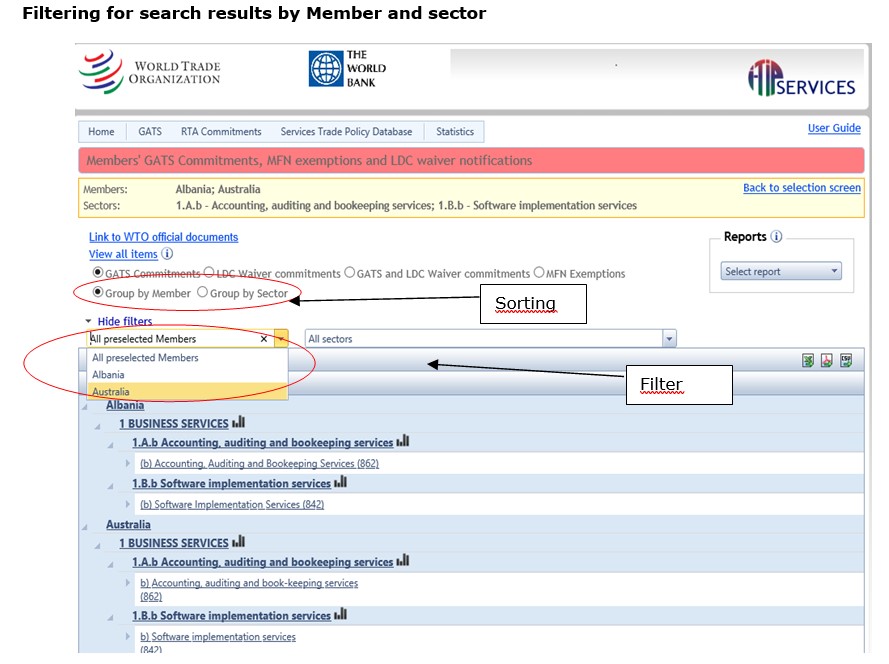
3.3.3.4 Detailed view of the results
While the selection results are initially presented in an abbreviated and succinct manner to provide the user with a general picture of specific commitments and MFN exemptions, the database allows users to view the full details of selected commitments and exemptions.
The detailed view of specific commitments or MFN exemptions can be accessed in three ways:
- by clicking on the arrow icon next to the sector text to expand the details for a single entry;
- by clicking on “View all items” hyperlink at the top left-hand side of the result screen to expand the details for all entries of the selection. This also concatenates all results on a single page. To revert to the succinct presentation, users can click on “Hide all items”;
- by clicking on the underlined text of the sectoral entry in the “commitment” column (e.g. by clicking on BUSINESS SERVICES, 1.F Other Business Services, a new tab presents the full text of the commitment for that particular service sector).
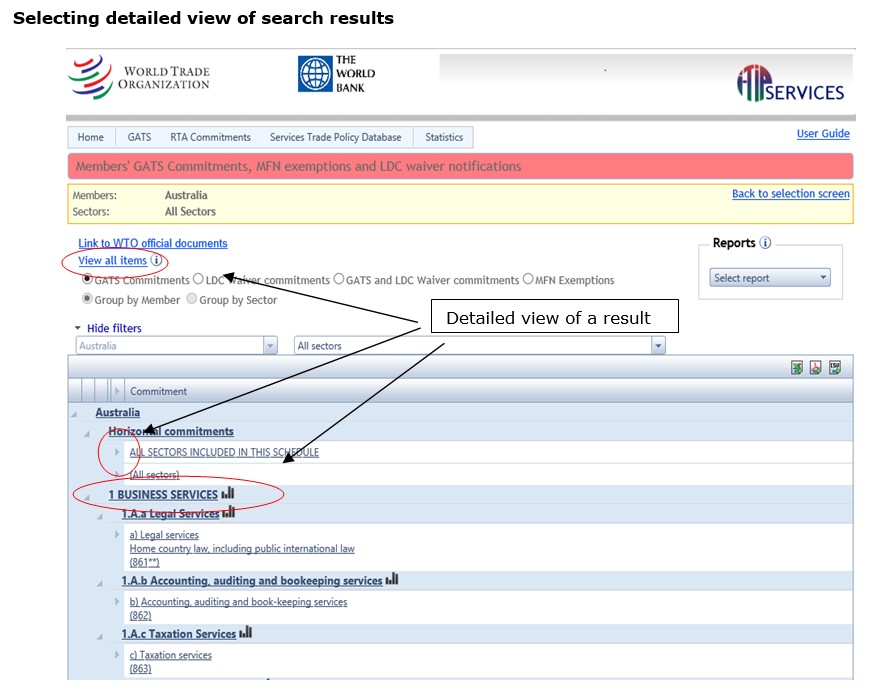
For GATS and LDC waiver commitments, the detailed view presents the full sector text, as well as the associated limitations on market access and national treatment, and additional commitments as presented in schedules. Users need to keep in mind that sector-specific commitments always need to be read in conjunction with those applying across sectors.
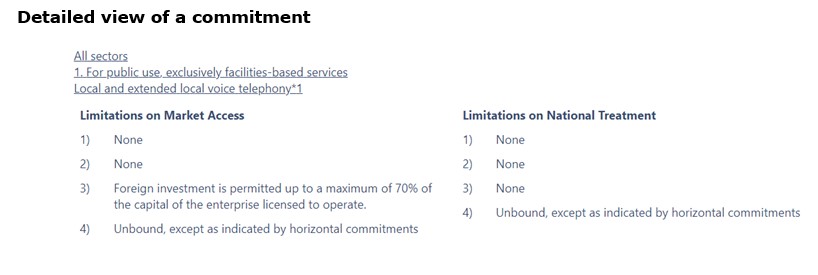
For MFN exemptions, the detailed view shows the services concerned by the exemption, the description of the measures, the countries to which the measure applies, the intended duration and the conditions creating the need for the exemption.
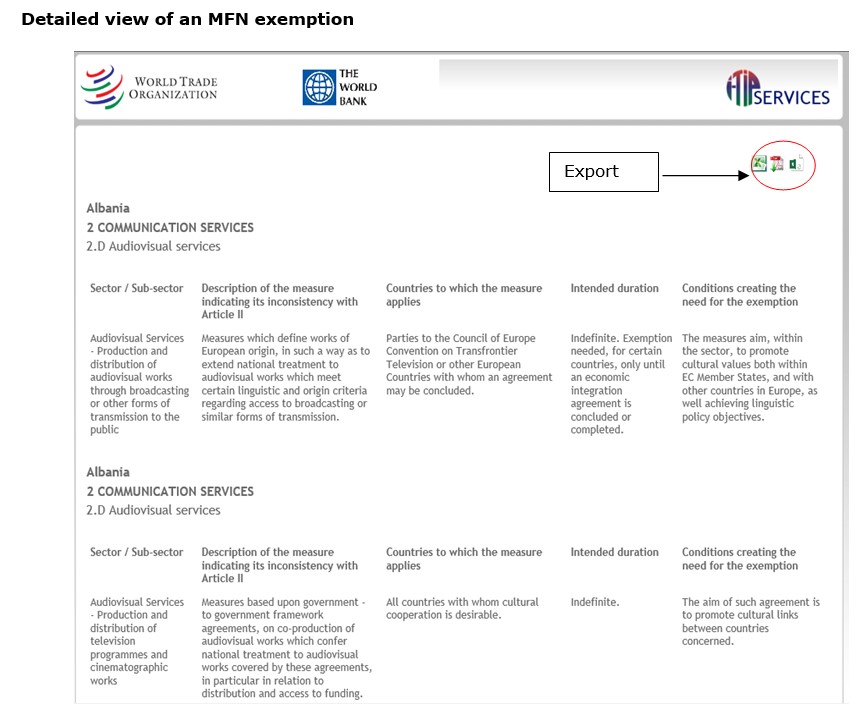
3.3.3.5 Detailed view of all commitments/exemptions for specific Members or sectors
To see the detailed view of commitments and/or exemptions in all the selected sectors for a specific Member, click on its name. In the same way, if you have grouped the information by sector, by clicking on the (sub)sector name, the user can see the detailed view of commitments and/or exemptions in all the selected Members for a specific (sub)sector. The Member's name and the (sub)sector titles are underlined and in bold.
3.3.3.6 Export to Excel, csv or PDF format
Results shown in the table or detailed view can be exported in Excel, csv or PDF format by clicking on the relevant icon on the top right-hand side of the table or window.
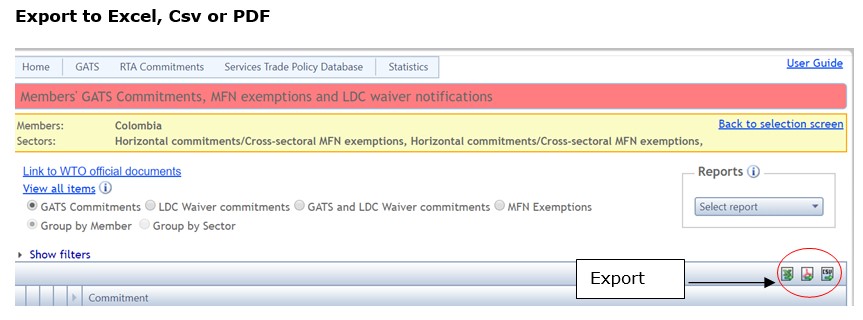
Note that there are also download options on the selection page (including an option to download the entire dataset in csv format). The download file is saved to the computer with the name “GATS_commitments”. The excel and csv formats are described as follows: The first column “Member” shows the name of the Member; “RegimeType” refers to either GATS Commitments or LDC Waiver. “SectorCode” contains the sector codes from the Services Sectoral Classification List (MTN.GATS/W/120) followed by the respective name in “SectorName”. This should not be confused with “SectorText” which includes the original sector description that was provided by Members in their original schedules. Market access commitments are displayed in columns “MA1” to “MA4”, where numbers refer to the mode of supply, while national treatment commitments are displayed in columns “NT1” to “NT4”. Lastly, headnotes, additional commitments and footnotes — if any — will appear in “Headnotes”, “AdditionalCommitment” and “Footnotes”.

3.3.4 Reports
At the bottom (right-hand side) of the home page of the GATS module or at the top left-hand side of the results page, the user can access several summary analytical reports. By clicking on the “Reports” button, the user may obtain reports on GATS commitments by sector, GATS commitments by detailed subsectors (at the level of the W120), and MFN exemptions by sector. The reports, once generated, can be downloaded in Excel, csv and pdf formats.
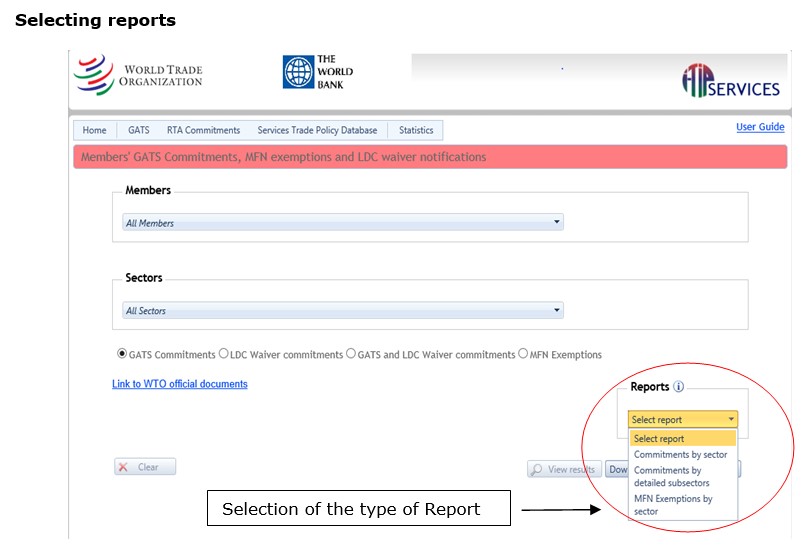
The report “GATS commitments by sector” shows, in table form, which (and how many) Members have undertaken GATS commitments in each of the 12 W120 sectors. The total in the last column indicates the number of sectors in which each Member has undertaken commitments. The total in the last row indicates the total number of Members with GATS commitments in each sector. Clicking on “View” in the “HC text” column opens a new tab showing the detail view of the Members' horizontal commitments.
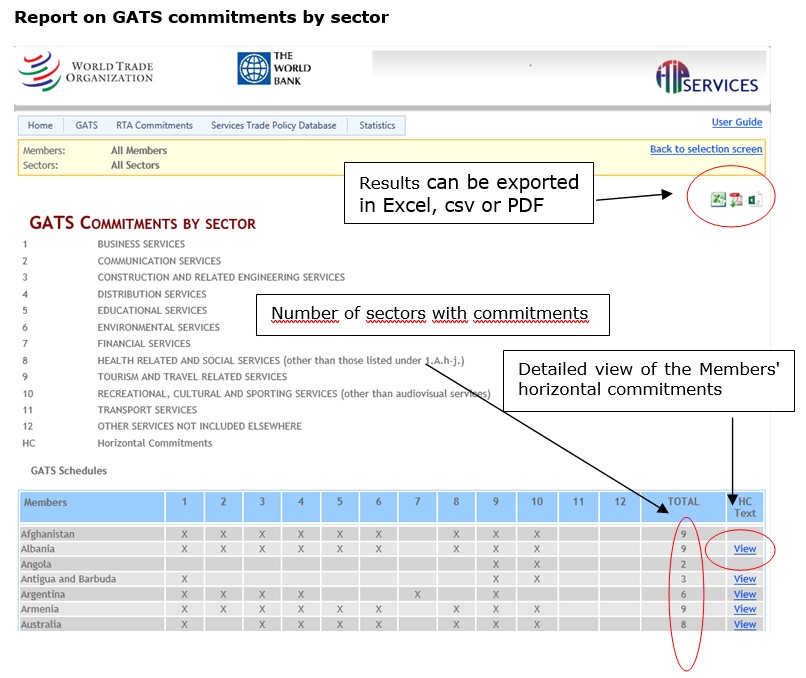
In the RTA module, it is also possible to produce reports comparing the sectors committed in GATS with the commitments made in RTAs. See section. 4.2.3.
The summary report “GATS commitments by detailed subsectors” shows specific commitments of selected Members across all subsectors that have been selected. The table provides information for all W120 subsectors. The total in the last row indicates the total number of subsectors in which GATS commitments have been undertaken by each Member. The last column shows the total number of — selected or all — Members that have made commitments in the relevant subsector. Only results for up to 10 Members can be displayed on the screen, but if more than 10 are selected, the full selection will be downloadable in Excel and csv. Clicking on the subsector in the first column opens a new tab showing the detailed view of the corresponding commitments of Members appearing in the table.
In the RTA module, it is also possible to produce reports comparing the subsectors committed in GATS at the 2-digit level of W120 with the commitments made in RTAs. See section. 4.2.3.
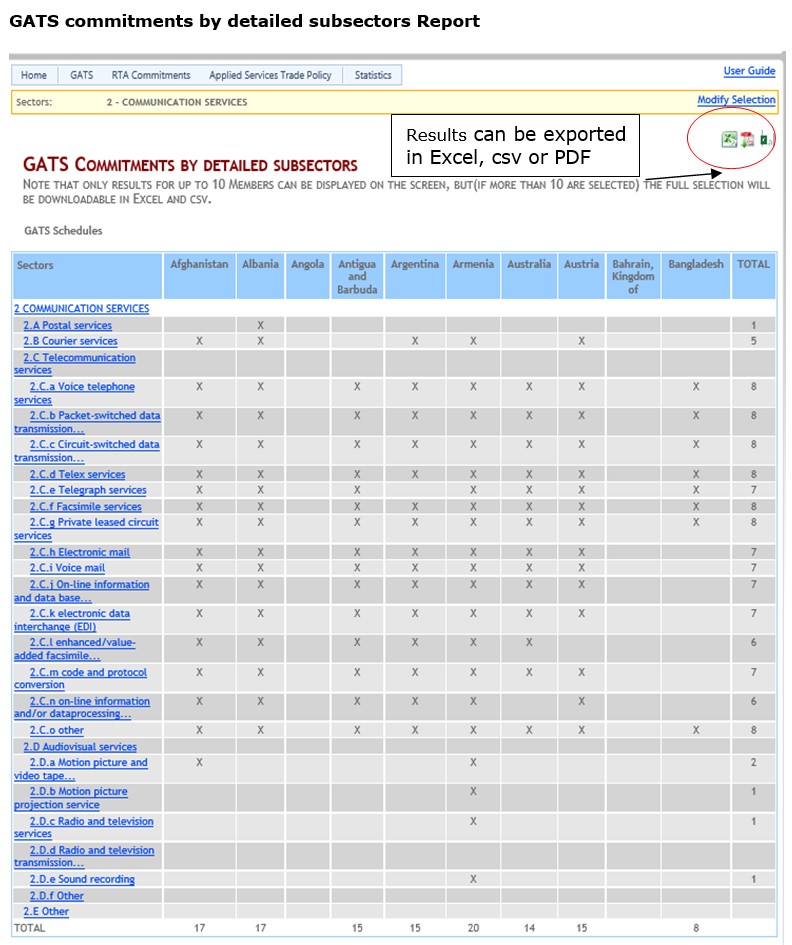
The report on GATS MFN exemptions by sector shows, in table form, the number of exemptions to the GATS most-favoured-nation (MFN) obligation, by Member and by the 12 W/120 sectors. Numbers in the table indicate the number of MFN exemptions undertaken by each Member, per sector. The column “total — sectors” indicates the number of sectors where each Member has undertaken exemptions, while the column “total — exemptions” indicates the number of MFN exemptions undertaken by each Member across all sectors selected. Clicking on the name of the Member opens a new window showing the details of the MFN exemptions. Reports will only list those Members that have undertaken MFN exemptions in sectors selected.
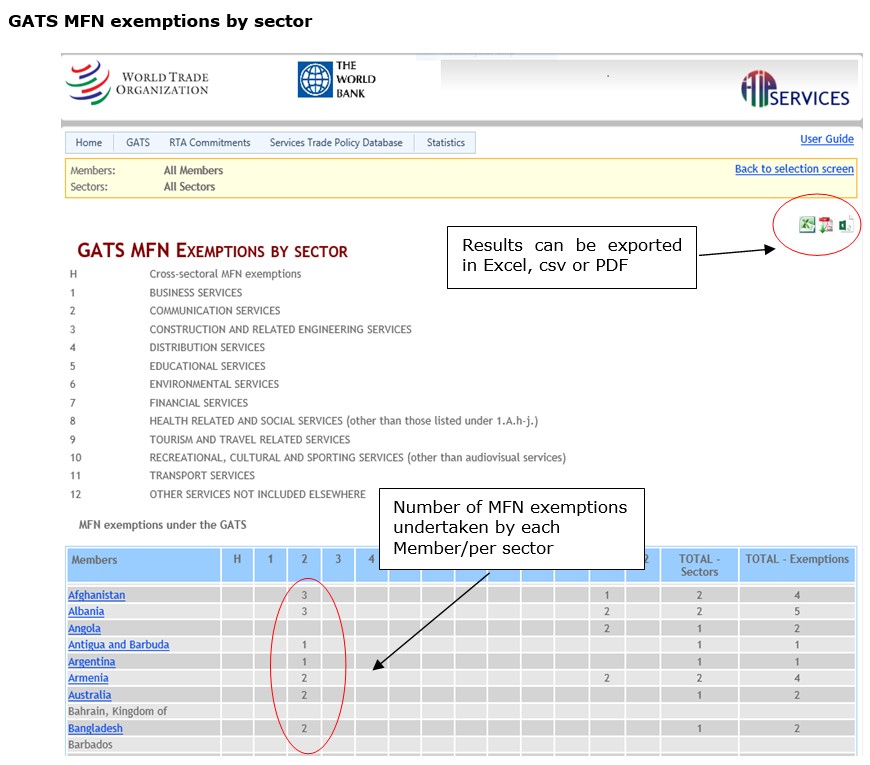
back to top
4. RTA commitments module
This module contains information on all services commitments and reservation lists undertaken by WTO Members in their regional trade agreements (RTAs). The module focusses therefore on the schedules of commitments and lists of reservations in RTAs. Among other things, the module permits to search by Member, by RTA, by sector/sub-sector, and to compare commitments undertaken by one or several Members across different agreements.
The database currently covers a majority of the RTAs notified under Article V (Economic Integration) of the GATS. The list of RTAs covered in the database can be accessed from the I-TIP Services portal. Additional agreements are added over time.
4.1 RTA commitments and ITIP
The disciplines on services contained in RTAs, including their scope and liberalization modalities, often differ from those of the GATS. Users need to keep this in mind when consulting the information. For this reason, the module provides, among other things, direct links to the relevant text of the obligations, chapters and commitments of the RTAs, as well as a succinct description of the main features of each services RTA (see below).
A key difference between RTAs lies in the modality adopted to liberalize trade in services and the related approach to scheduling commitments and/or reservations/limitations. The approach used in the GATS and in RTAs based on that model is often described as a “positive-list” approach. According to that approach, a party to an RTA grants market access and national treatment to the services and service suppliers of the other party/parties only in the sectors explicitly listed in its schedule of specific commitments. The schedules of commitments generally follow the GATS format, and, as in the GATS, parties indicate the level of market access and national treatment granted for each mode of supply. The market access and national treatment obligations do not apply therefore to sectors/modes for which 'unbound' has been entered or that are absent from the schedule.
In contrast, several services RTAs adopt the so-called “negative-list” or “top-down” approach. According to this approach, market access and national treatment, among other obligations,(5) apply fully to service sectors covered by the RTA, except to the extent that non-conforming measures (commonly referred to as “reservations”) providing otherwise have been listed in annexes. In other words, under this approach, everything is in principle liberalized (i.e. there is a commitment for these sectors) unless otherwise indicated in the annexes. In negative-list agreements, reservations are typically of two main types, each recorded in separate annexes: Annex I, reservations concerning existing non-conforming measures (i.e., those that are applied at the time of entry into force of the agreement); and Annex II, for reservations allowing for the introduction of non-conforming measures in the future.
- The categories of obligations found in negative-list type RTAs are listed below. In parentheses are the abbreviations used in ITIP.
- Market access (MA): obligation similar to that of Article XVI of the GATS, which prohibits a limited number of limitations, whether discriminatory or not.
- National treatment (NT): obligation providing for non-discrimination between foreign and domestic services and service suppliers.
- Most-favoured-nation treatment (MFN): obligation providing for non-discrimination between different foreign services and service suppliers.
- Local presence requirement (Local Pres.): obligation typically prohibiting a Party from requiring suppliers of the other Party to establish a commercial presence in its territory or to be resident as a condition for the provision of a service across borders.
- Senior management and board of directors (Senior mgmt.): obligation typically forbidding nationality and/or residence requirements for senior managers or directors of companies of the other party/parties.
- Performance requirements (Perf. Req't.): obligation prohibiting parties from imposing a defined set of requirements in relation to the establishment or operation of an investment of another party.
- Quantitative restrictions (Quant. restr'ns): obligation generally providing that parties list in an annex the quantitative restrictions that they maintain (ex: NAFTA article 1207)
- New financial services: obligation where parties commit to permitting a financial institution of another party to supply 'new' financial services.
The RTA module allows users to search and obtain information on commitments/reservations in all types of RTAs. At the same time, there are some differences in the way the commitments/reservations of different types of RTAs are displayed, both in the overview of results and in the detailed views.
4.2 How to use the RTA module
4.2.1 Making a selection
After clicking on the ‘RTA’ icon on the I-TIP Services home page, the “selection criteria” page appears under beige banner.
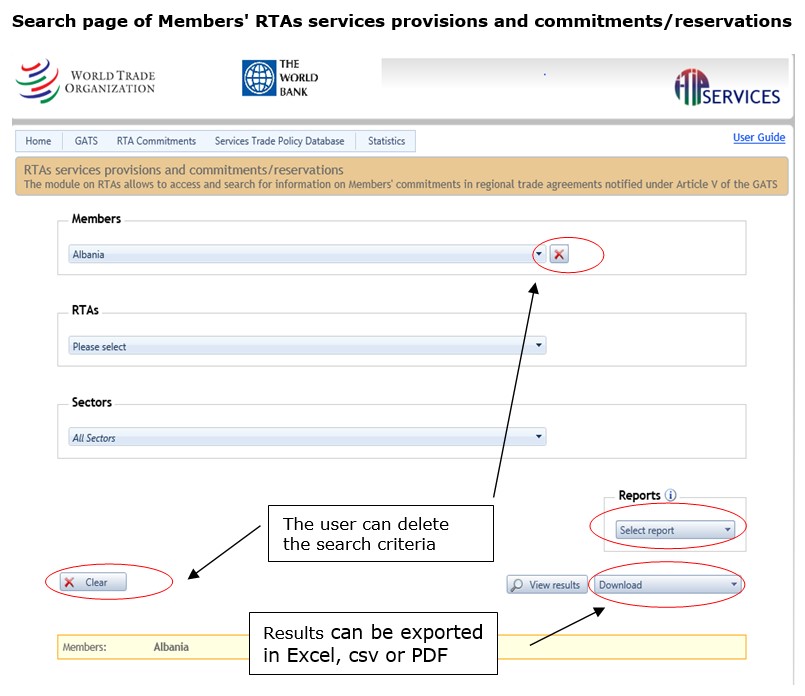
A drop-down list permits the selection of economies or groupings of economies (see section 2.1.3). It is also possible to limit the search to one or more service sectors, sub-sectors, or horizontal commitments/reservations (see section 2.1.2).
To proceed with the search, it is necessary to also identify the relevant RTAs. Once an economy has been selected, the RTA to which they are party and which are covered in the database will appear in the “RTAs” drop-down list. This allows the user to select the RTAs of interest. By clicking on “All RTAs”, the commitments of all the parties to the RTAs available in the database will be included in the search.
The search criteria entered appear at the bottom of the screen (in yellow). To delete the search criteria entered, click on the red “X” next to the drop-down lists or on the “X clear” button (to delete all search criteria).
To visualize the results of the selection, press the “view results” button.
From the selection screen, it is also possible to download directly the selected information into Excel, csv or pdf formats (see dropdown menu “Download” at the bottom right-hand side of the screen). A bulk download facility for all the information on RTAs is also available (csv format). A description of the Excel and csv files is provided in section 4.2.2.6.
Finally, summary reports can be accessed directly from the selection page (see section 3.3.4 for a description of the GATS summary reports).
4.2.2 Overview of selection results
The results of the search defined by the user are first presented in an overview page. Its purpose is to present a general picture of the selected commitments. Below are two examples. The first one results from the following selection criteria:
Member: Australia
RTA: Australia-Chile
Sector: 1 — Business services
It therefore shows the reservations of Australia on business services in the Australia-Chile RTA, which is based on a negative-list approach.
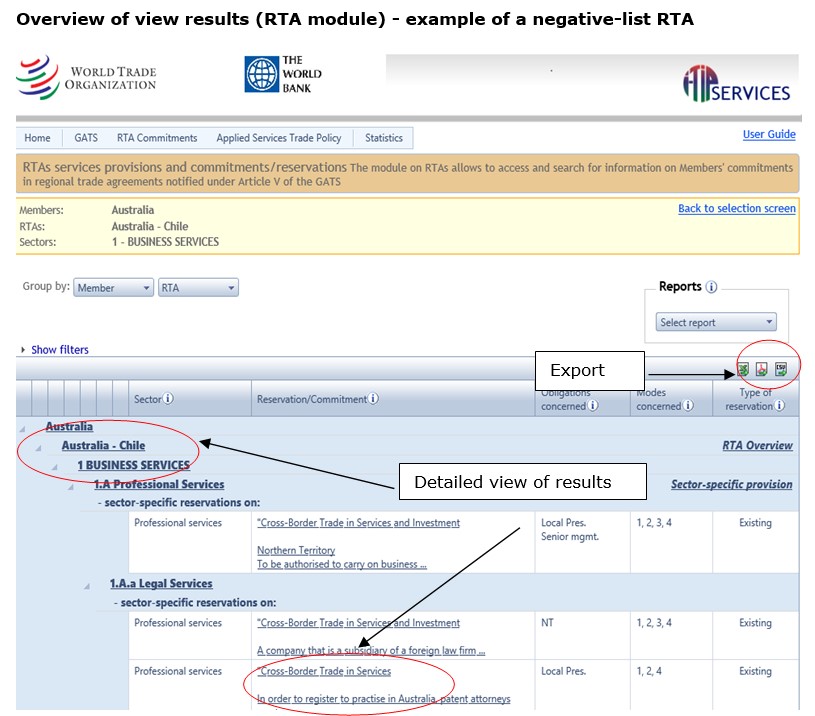
The second example results from the following selection criteria:
Member: Chile
RTA: Chile-China
Sector: 1 — Business services
This shows the commitments of Chile on business services in the Chile-China RTA, which adopts a positive-list approach.
The results are presented in summary form in the table. By default, the results are ordered by Member, then by RTA, and then sector/sub-sector.
When the amount of information presented is considerable, the user can move to different pages of results by scrolling down and using the relevant icons at the bottom of the table. The possibility to show more or all results on a single page is also available at the bottom of the page. The print function of the browser can be used to print the view results.
The following sub-sections explain the different components of the table presenting the overview of view results for the RTA module.
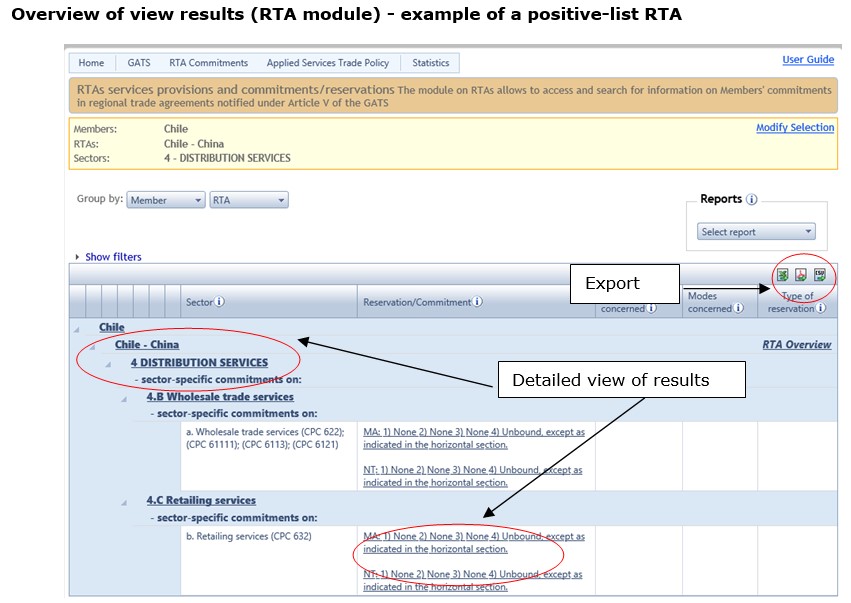
4.2.2.1 Main features
In the overview results page, while the format used is the same for negative or positive-list RTAS, but the information displayed varies.
Negative-list agreements
In the case of negative-list agreements, only the services sectors where reservations have been undertaken for non-conforming measures are listed. Unless otherwise indicated in the RTA concerned, services not listed are therefore not subject to measures inconsistent with the agreement's liberalization obligations (i.e., there are no restrictions).
In negative list-type of RTAs, the “Reservation/Commitment” column provides a preview of the reservations by listing the first words of the description of the non-conforming measure. Note that this will also indicate whether the reservation concerns the chapter on (Cross-border) Trade in Services and/or the Investment chapter. A detailed view of the reservation appears in a new tab by clicking on the underlined text.
The column on “Obligations concerned” will indicate the obligations for which the reservation has been taken, as indicated in the relevant reservation list. The standard list of obligations used in ITIP is Market access (MA), National treatment (NT), Most-favoured-nation treatment (MFN), Local presence requirement (Local Pres.), Senior management and board of directors (Senior mgmt.), Performance requirements (Perf. Req't.), Quantitative restrictions (Quant. restr'ns), New financial services. In parentheses are the abbreviations used in ITIP. A further description of the respective obligations is provided in section 4.1.
In some cases, the “obligations concerned” column will contain the annotation “Mode 4 chapter”. This indicates that the scope of commitments on mode 4 is defined through a dedicated chapter of the RTA. Clicking on the underlined text permits access to the chapter.
The column “Modes concerned” will mention the modes affected by the reservation.
Finally, the column on “Type of reservation” indicates whether the reservation concerns existing or future measures.
Positive-list agreements
In the case of positive list-type of RTAs, the “Reservation/Commitment” column shows, for each subsector, the sectors with commitments, as well as the level of commitments on market access and national treatment for each mode of supply. Since the obligations concerned (market access and national treatment) and the modes of supply are already indicated in the “Reservation/Commitment” column, the columns on “Obligations concerned” and “Modes concerned” appear empty.
Since these types of agreements do not distinguish between reservations for existing and future measures, the column on “Type of reservation” is also left empty. Only the sectors for which market access and national treatment commitments have been made by the party concerned are displayed. Services for which no commitments have been made are not displayed. In the latter case, if the specific sector has been chosen in isolation, then the indication “no records to display” will appear. If the sector without commitments has been included within a broader selection of sectors, then the sector will be visualized on the page, but the “Reservation/Commitment” column will be empty.
4.2.2.1.1 Overview of scope and architecture of RTAs
Summary information on the scope and architecture of each RTA is provided. This information can be accessed by clicking on the “RTA overview” link, which appears on the right of each RTA listed in the table. A PDF file then opens, providing a brief overview of the RTA concerned.
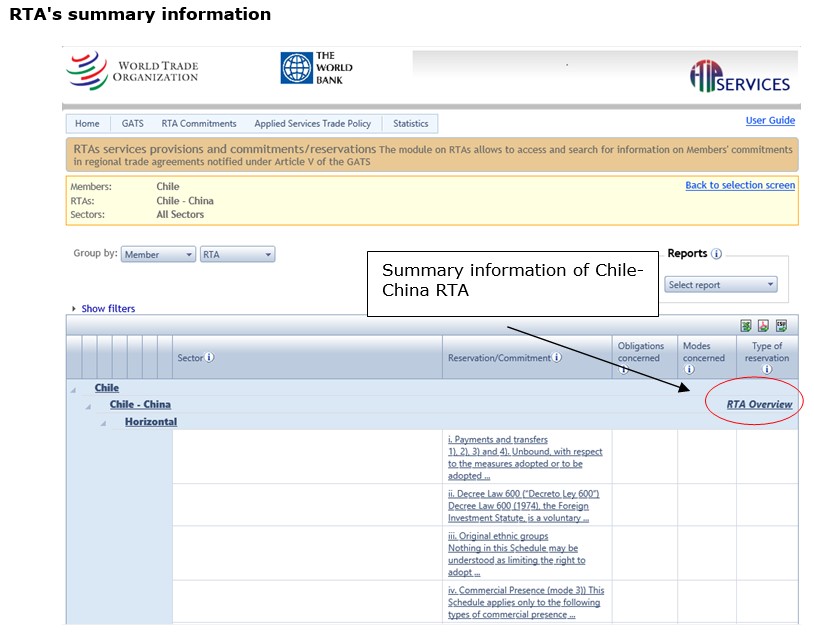
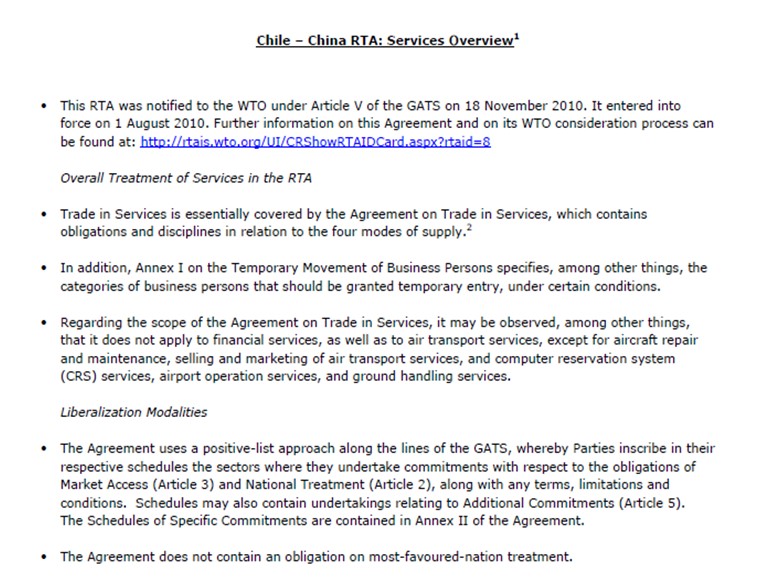
While not substituting for a more detailed reading of the agreement, the overviews provide basic information to help consult the commitments made or reservations entered under an RTA. It summarizes the main features of the agreement as regards services, indicates the relevant chapters and their general coverage, enumerates the main obligations, and briefly describes the liberalization modalities and the content of related annexes. A link to the consideration process of this RTA in the WTO (including any Factual Report) is provided.
4.2.2.1.2 Sector-specific provisions
RTAs often contain provisions that are specific to particular service sectors. Examples of such sector-specific provisions would be RTAs' chapters on telecommunication containing a set of regulatory disciplines or dedicated annexes on professional services. Clicking on “ Sector-specific provision”, which appears in the table next to relevant sector headings, opens a new tab with the full text of such provisions.
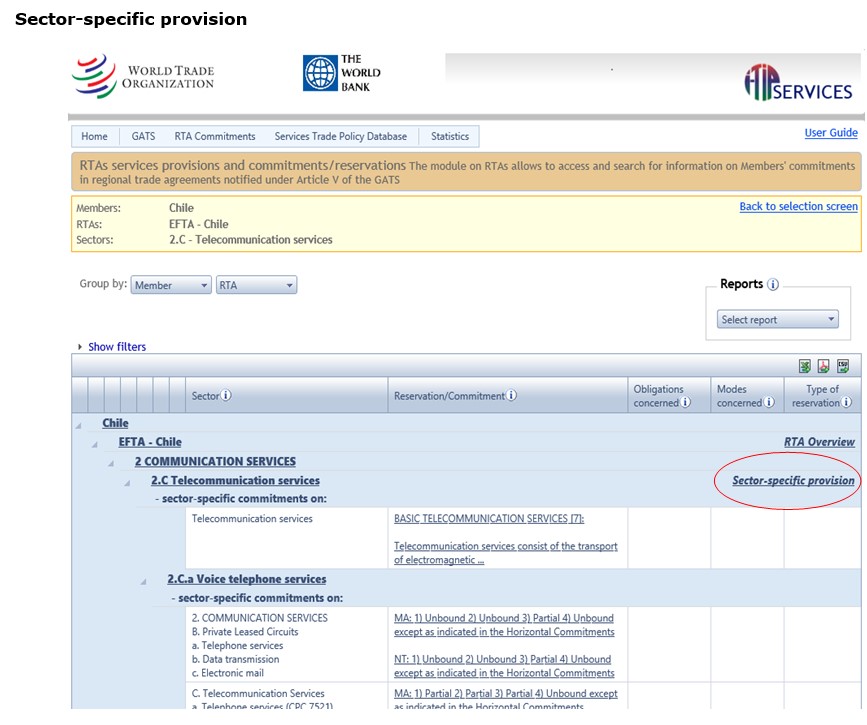
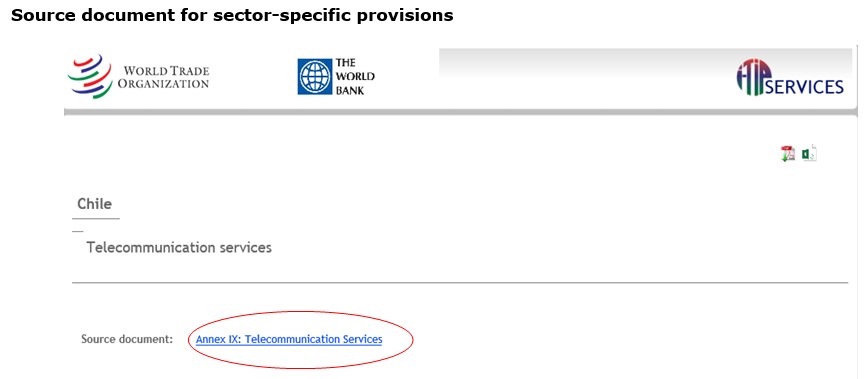
4.2.2.2 Sorting
When selection results are presented for more than one economy or more than one RTA, the user has the possibility to modify the sorting of the results. By default, the results are ordered by economy, then by RTA, and then by sector. For example, if the user wants to see all commitments and reservations of Chile and Australia in all their RTAs, the table first presents Australia's commitments in RTA no. 1 for all sectors, then Australia's commitments in RTA no. 2, etc.
Using the “Group by” options above the table allows modifying the ordering, for example by sorting all selected commitments/reservations by sector first. In this case, the user will see for sector 1 Australia's and Chile's commitments for sector 1, followed by sector 2, etc.

4.2.2.3 Filters
The database offers the possibility to filter the view results by Member, RTA, and sector, allowing the user to visualize the results for only one of the Members selected and/or one of the sectors or RTAs at a time. To do so, click on “show filters” (above the results table), and then select using the respective drop-down lists. The option is also given to filter the obligations, modes and types of reservations for negative type agreements.
To return to a full view of the view results, click on “X Clear filters”.
4.2.2.4 Detailed view of the results
While the selection results are initially presented in an abbreviated and succinct manner to provide the user with a general picture of RTA commitments/reservations, the database enables the user to display the full details of selected commitments and reservations.
The detailed view of a particular commitment/reservation is accessed by clicking on the underlined text of the sectoral entry in the “reservation/commitment” column. A new tab then opens up and presents the full information relating to the commitment or reservation for that particular service sector.

For positive-list entries (commitments), the presentation is similar to the one used in I-TIP for GATS specific commitments. The sector in which the commitment is undertaken (the first column in original GATS schedules) is presented in a row. Below, market access, national treatment, as well as any additional commitments, are presented in columns.
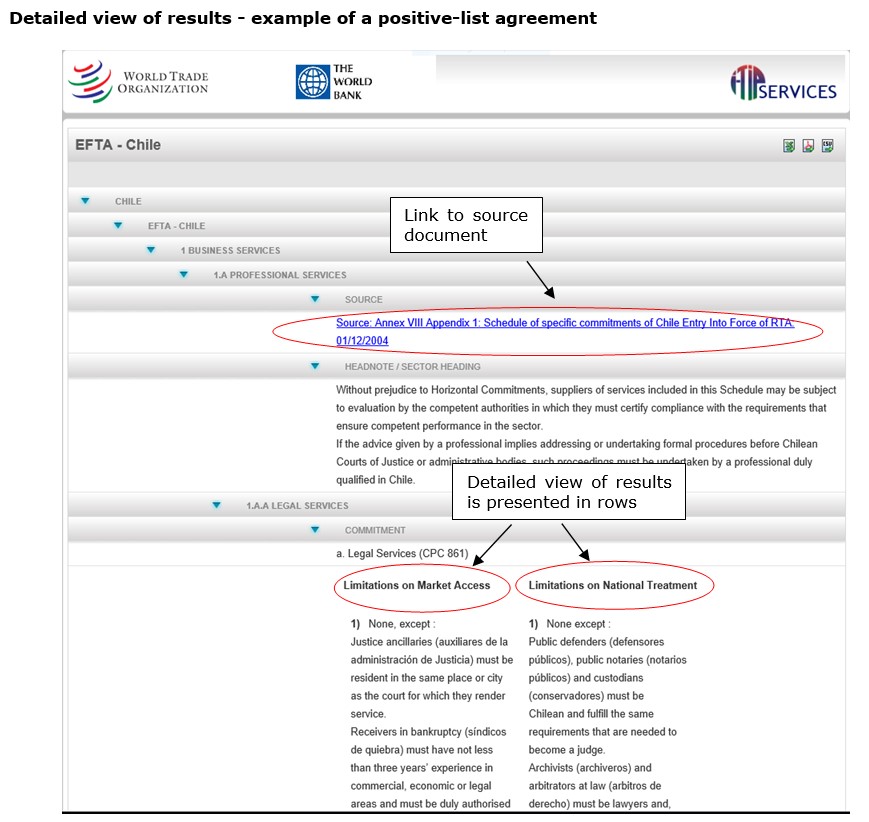
For negative-list entries (reservations), the presentation reflects to a large extent the format used in lists of reservations. It contains the following fields, which all contain information lifted from the RTA official documents:
- Sector: text from the RTA that indicates the sector and/or sub-sector in which the reservation is taken, along with any reference to classification systems.
- Comments: description of the non-conforming measure.
- Relevant laws: indicates any laws/regulations relating to the non-conforming measure(s), as listed in the RTA.
- Level of government: this field appears when the RTA specifies that the non-conforming measure relates to a level of government other than the central one (e.g., regional, local, provincial). The name of the sub-central entity is displayed when mentioned in the agreement.
- Phase-out: this field appears when the RTA specifies that a non-conforming measure is subject to a partial or complete phase-out over time. The date of complete phase-out is provided.
- Obligations concerned: indicates the obligation(s) for which the reservation is taken, i.e., the obligation(s) that do not apply to the measure listed. The database allows consulting the text of the obligation (e.g., “Article XYZ: National treatment”) by clicking on it. Next to each obligation appears the name of the chapter in which the obligation is contained (e.g., “Chapter A: Cross-border trade in services”). Again, clicking on the name of the chapter allows consulting the original text (normally in PDF format).
- Source: indicates the section of the RTA where the text of the non-conforming measure is found, typically an annex. Clicking on the name of the annex permits consulting the original text (normally in PDF format).
- Entry into force of the agreement: date of entry into force of the RTA, as notified to the WTO.
Users need to keep in mind that sector-specific reservations/commitments always need to be read in conjunction with those applying across sectors.
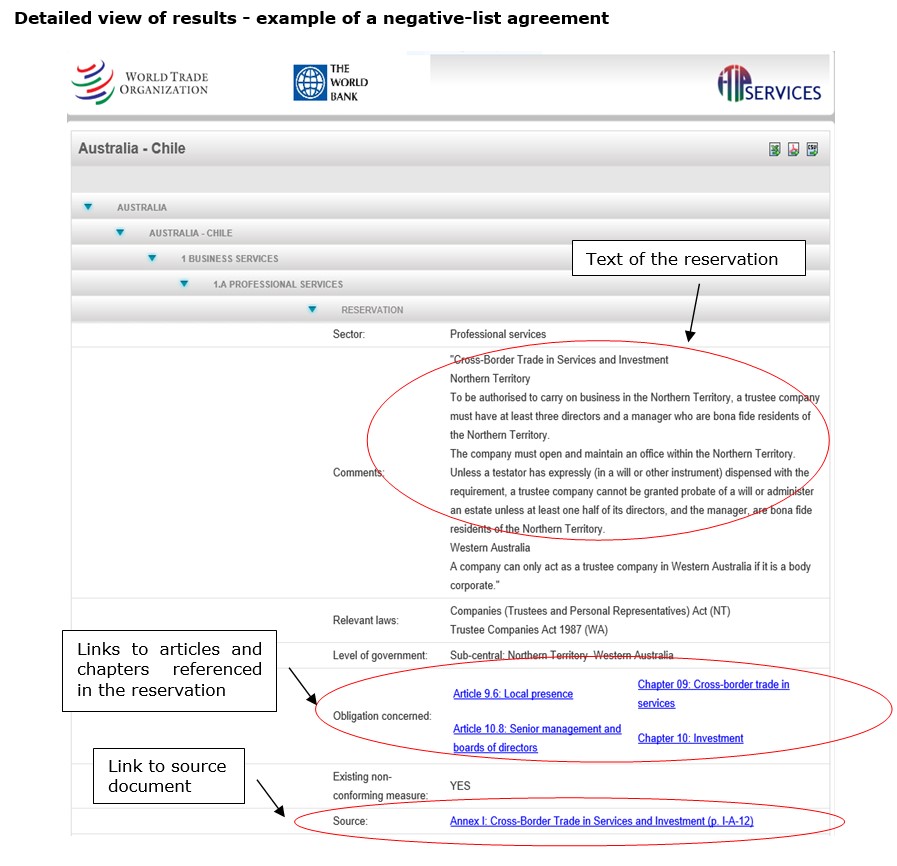
4.2.2.5 Detailed view of all commitments/reservations for specific economies and sectors
To see the detailed information for commitments/reservations in all selected sectors for an RTA or an economy, click on the name of the RTA or the economy, respectively. Users can also view the detailed information concerning all subsectors belonging to a sector by clicking on the sector name. Similar features are available with other sorting options. All headings for which you can view detailed information are underlines and in bold.
4.2.2.6 Export in Excel or PDF format
Results shown in the table or detailed view can be exported in Excel, csv or PDF format by clicking on the relevant icon on the top right-hand side of the table or window. Note that there are also download options on the selection page (including an option to download the entire dataset in csv format). A compressed zipped folder is saved to the computer that includes two different files.
Firstly, “RTA_commit” contains the positive-type agreements of the selection. For the Excel and csv formats, it follows the same structure as the file download of GATS commitments explained in section 3.3.3.6. In addition, it provides the name of the agreement in “RTA”, the date of entry into force of the agreement in “EntryIntoForce” and the name of the original schedule in “Source”.

Secondly, “RTA_res” contains the negative-type agreements of the selection. For the Excel and csv formats, its structure is very similar, however, the reservation text is displayed in “Comment”, followed by the corresponding laws (“RelevantLaw”), obligations (“Obligation”), articles from the agreement (“Articles”), and to which government level it applies (“LevelOfGovernment”). The respective modes of supply to which the reservation refers is displayed in “ModesConcerned”. Lastly, “ReservationType” shows whether the reservation is an existing or future measure. Please note that for instance, if no negative-type agreement was selected, the respective download file will be empty.

4.2.3 Reports on RTAs
At the bottom (right-hand side) of the home page of the RTA module or at the top right-hand side of the results page, the user can access several summary analytical reports, through the drop-down list in the “Reports” command. The reports, once generated, can be downloaded in Excel, csv and pdf formats.
The report “RTA commitments by sector” shows, in table form, sectors where economies have undertaken services commitments in their different regional trade agreements (RTAs). The table provides an overview of commitments in the 12 sector groups of the Services Sectoral Classification List. The total in the last column indicates the number of sectors in which each economy has undertaken commitments. Clicking on the name of the RTA opens a new window showing the details of relevant economies' commitments. Economies' horizontal commitments/reservations can similarly be accessed directly from the table (“HC Text” column).
The report “Compare to GATS: RTA commitments by sector” adds the GATS commitments in the comparison.
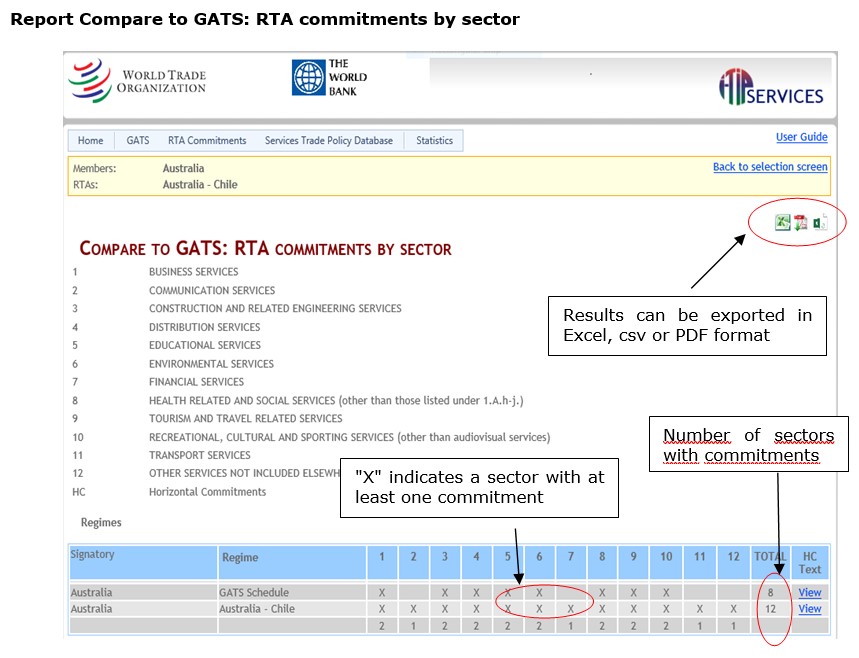
The summary report “RTA commitments by detailed subsectors” shows specific commitments of selected economies in regional trade agreements (RTAs) across subsectors at the two digit level of W120 (the total number of subsectors at the 2-digit level is 55) The total in the last row indicates the total number of subsectors in which RTA commitments have been undertaken by each economy. Results for a maximum of 10 economies/RTAs can be presented in the table on the webpage. However, schedules of up to 255 economies/RTAs can be considered when the table is exported to Excel. Clicking on the sector or subsector in the first column opens a new window showing the details of the corresponding commitments or reservations of economies appearing in the table.
The report “Compare to GATS: RTA commitments by 2-digit detailed subsectors” adds the GATS commitments in the comparison.
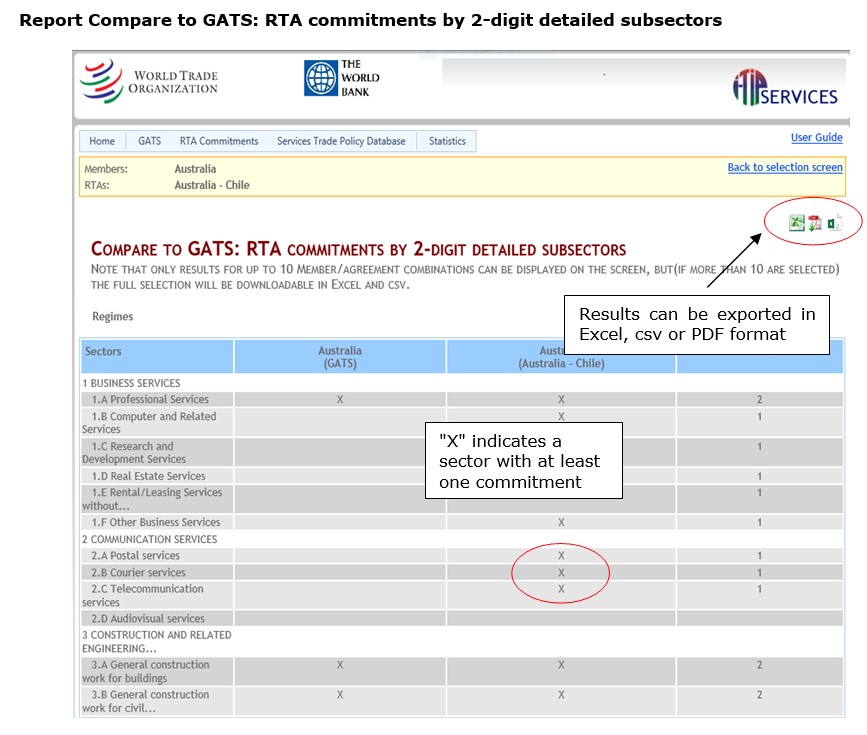
back to top
5. Services Trade Policy Database module
This module provides information on applied measures that affect trade in services in a range of subsectors.
5.1 Content of the Services Trade Policy Database
The Services Trade Policy databased module provides information jointly compiled by the World Bank and the WTO Secretariat. Information is currently available for 68 economies (32 developed and 36 developing and Commonwealth of Independent States (CIS) economies), representing the most important services traders around the world. For 25 of these economies, the information was collected through a survey conducted jointly by the World Bank and WTO, while the information for the remaining 43 economies was sourced from the OECD STRI regulatory database (2016 vintage), thanks to the co-operation of the OECD, which is gratefully acknowledged.
In this module the list of sectors/sub-sectors is adapted to the narrower list of subsectors covered by the World Bank-WTO survey (and the OECD database), as well as the necessity to adapt definitions to the way certain sectors are regulated. The box below lists the subsectors covered by the Services Trade Policy database and the definitions used for these individual subsectors.
Box 1 Subsectors covered
| - Professional services (Legal, Accounting and auditing services) Legal services: Host country representation services: Court appearances/oral arguments: Legal representation of one party’s interest against another party, before the courts or other domestic judicial or quasi-judicial bodies, whether concerning criminal law or other than criminal. Also covered are representation services in statutory procedures of quasi-judicial bodies. The following are excluded: activities in relation to the administration of public justice (such as judges); and notaries who typically perform their activities as public officials and are subject to a different regulatory regime. Legal services: Home country law and/or third country law (advisory/representation): General counselling, advice and drafting of documents and other related legal services concerning foreign or international law. International law includes advisory services in home country law (i.e. law of the country of the foreign supplier or foreign law), third country law, international law, as well as a right to appear in international commercial arbitration. It also covers advisory services in statutory procedures of quasi-judicial bodies. Excluded are activities in relation to the administration of public justice (such as judges); and notaries who typically perform their activities as public officials and are subject to a different regulatory regime. Legal services: Host country advisory services: General counselling, advice and drafting of documents and other related legal services concerning domestic law (i.e. the law of the jurisdiction under review), whether criminal law or other than criminal. Also covered are advisory services in statutory procedures of quasi-judicial bodies. The following are excluded: activities in relation to the administration of public justice (such as judges); and notaries who typically perform their activities as public officials and are subject to a different regulatory regime. Accounting services: The collection, recording and extraction of financial information, and the summary of it in the form of a periodic profit and loss account, a balance sheet and a cash flow statement in accordance with legal, professional, and capital market requirements (e.g. accounting review, compilation of financial statements). Bookkeeping services are included here as the difference in regulation between accountants and book-keepers are typically small or not existent. In most jurisdictions, book-keeping is synonymous with accounting and is not separately regulated. Auditing services: The examination and assessment of the activities, controls, records and systems that underpin accounting information and reports. Financial audits are typically performed by firms of practicing accountants due to the specialist financial reporting knowledge they require. - Telecommunications services (Fixed, mobile, Internet) Fixed-line telecommunication services: The transmission and reception of signals through wired networks. Fixed-line telecommunications covers local as well as long-distance telephony services. Mobile telecommunication services: The transmission and reception of signals through wireless networks. Internet services: Carrying of electronic signals (traffic) over the Internet, providing access to the Internet, providing telecommunications services on the Internet and similar distributed computer networks that rely on, but are not part of, the normal telecommunications network. - Distribution (Retail and wholesale) Retailing services: Resale of new and used goods mainly to the general public for personal or household consumption or utilization, by shops, department stores, stalls, mail-order houses, hawkers and peddlers, consumer cooperatives etc. Relevant are the laws, regulations rules, guidelines etc. which apply to the retail trade sector in general. Particular product regulations regarding the retail sale of specific types of products (e.g. tobacco, alcohol, pharmaceutical products) are not taken into account. Wholesale trade services: Resale of new and used goods to retailers, to industrial, commercial, institutional or professional users, or to other wholesalers, or involves acting as an agent or broker in buying goods for, or selling goods to, such persons or companies. Wholesale covers the activities of wholesale merchants or jobbers, industrial distributors, exporters, importers, and cooperative buying associations, sales branches and sales offices (but not retail stores). Relevant are the laws, regulations rules, guidelines etc. which apply to the wholesale trade sector in general. Particular product regulations regarding the wholesale of specific types of products (e.g. primary agricultural or mining products, tobacco, alcohol, pharmaceutical products) are not taken into account. - Financial services (Commercial banking, life insurance, non-life insurance, reinsurance) Commercial banking: Most services supplied by banks, such as acceptance of deposits and other repayable funds from the public, lending of all types, financial leasing, guarantees and commitments, and payment and money transmission services. For the purposes of this exercise, commercial banking does not include the services typically supplied by investment banks, such as brokerage or trading of securities, securities underwriting services, and mergers and acquisitions (M&A) and corporate reorganization services. Life insurance: Insurance underwriting services consisting in making payments upon the death of the policy holder, or at the end of an agreed term, with or without a profit element. For the purpose of this exercise, accident and health insurance services are not covered. Non-life insurance: Non-life insurance or general insurance, provide payments depending on the loss from a particular financial event. General insurance is typically defined as any insurance that is not determined to be life insurance. It typically includes motor vehicle insurance, fire and other property damage insurance, pecuniary loss insurance, and general liability insurance. Also covered is marine, aviation and transport (MAT) insurance, i.e. the insurance of risks comprising maritime shipping, commercial aviation, space launching and freight (including satellites). Reinsurance and retrocession: Reinsurance is a financial transaction by which risk is transferred (ceded) from an insurance company (cedant) to a reinsurance company (reinsurer) in exchange of a payment (reinsurance premium). When it is a reinsurer that cedes risk to another reinsurer, the service is called retrocession. Providers of reinsurance are professional reinsurers which are entities exclusively dedicated to the activity of reinsurance (e.g. SwissRe). Also in most jurisdictions insurance companies are allowed to participate in reinsurance. - Transport (air freight-passenger domestic-international, rail freight, road freight, maritime freight and auxiliary services) Air freight domestic: Domestic air transport of freight on a scheduled basis. It covers air transportation of individual articles and packages assembled and shipped in specially constructed shipping containers designed for ease of handling in transport. It includes air transportation services of letters and parcels. Air freight international: International air transport of freight on a scheduled basis. It covers air transportation of individual articles and packages assembled and shipped in specially constructed shipping containers designed for ease of handling in transport. It includes air transportation services of letters and parcels. Rail: Freight transportation: The sector rail freight service providers (or carriers). Covered items are rail freight transportation of frozen or refrigerated goods, transportation of bulk liquids and gases, transportation of containerized freight, mail transportation and other freight. Inter-urban rail transport of freight is also covered. Road: Freight transportation: The sector covers freight transportation and relevant rental of commercial vehicles with operator. This definition entails transportation of frozen or refrigerated goods, transportation of bulk liquids or gases, transportation of containerized freight, transportation of furniture, mail transportation, freight transportation by man- or animal-drawn vehicles and transportation of other freight, whether domestically or internationally. Maritime: Freight transport: The sector covers the two main types of services offered by the maritime shipping industry, namely liner and tramp services, whether coastal or transoceanic. Cabotage is also considered. All types of goods transported should be covered (e.g. frozen or refrigerated goods; bulk liquids or gases; dry bulk goods such as cereals, flour, cement or sand; letters and parcels; goods that have been containerized for ease of transport). Rental services of freight ships with crew are also covered. Charter services are not covered to the extent that they are subject to a different regulatory regime. Maritime intermediation auxiliary services: Maritime agency, freight forwarding and customs clearance services are covered. In general, regulatory frameworks (laws, regulations, rules, guidelines, etc.) deal with these activities in conjunction, given that they are often conducted jointly and/or are substitutable. This refers to intermediaries/agents which are not related (i.e. no direct investment relationship) with the maritime shipping operators or ship owners. Maritime cargo-handling, storage, warehousing and container station depot services: In general, regulatory frameworks (laws, regulations, rules, guidelines, etc.) deal with maritime cargo handling, container depot station, and storage and warehouse activities as a package, given that these activities are often conducted jointly and in an integrated manner. Maritime cargo handling services are activities exercised by stevedore companies, including terminal operators, but not including the direct activities of Dockers, when this workforce is organized independently of the stevedoring or terminal operator companies. Container station and depot services means activities consisting in storing containers, whether in port areas or inland, with a view to their stuffing/stripping, repairing and making them available for shipments. |
The database includes information on the main measures (e.g. laws, regulations, policy guidelines, directives) affecting trade in services. These measures have been classified according to four main categories: A) conditions on market entry (i.e. requirements applicable to obtain an authorization to supply or to access the market); B) conditions on operations (i.e. conditions that will apply to the actual supply of services or to the service supplier); C) measures affecting competition (i.e. conditions that affect in particular the conditions under which firms compete); and D) measures pertaining to overall regulatory environment and administrative procedures. A final catch-all category – miscellaneous – has been kept to allow for the inclusion of relevant measures that did not clearly fit in any of the other categories.
Box 2: STPD classification of measures
A Conditions on market entry
A1 Forms of entry (including foreign equity limits)
A2 Quantitative and administrative conditions
A3 Conditions on licensing/qualifications relating to market entry
A4 Other conditions on market entry
B Conditions on operations
B1 Conditions on supply of services
B2 Conditions on service supplier
B3 Conditions on government procurement
B4 Other conditions on operations
C Measures affecting competition
C1 Conditions on conduct by firms
C2 Governmental rights/prerogatives (including public ownership)
C3 Other measures affecting competition
D Regulatory environment and administrative procedures
D1 Regulatory transparency (including licensing)
D2 Nature of regulatory authority (measures related to nature of regulator)
D3 International standards
D4 Conditions related to administrative procedures
D5 Other regulatory environment and administrative procedures
E Miscellaneous
E1 Miscellaneous measures
E2 Other miscellaneous
Each category is further broken down into sub-categories.
Links to other useful sources of information on applied services policies are also provided (e.g. WTO DG monitoring reports, WTO Trade Policy Reviews (TPRs)).
This module does not pretend to be exhaustive, but rather aims at facilitating access and search across already available sources of information or information collected by the World Bank and the WTO Secretariat through surveys. Although efforts are constantly made to update and expand the database, the available information may not necessarily be up-to-date – the information presented on this site can only be considered valid as of the date indicated. Members are invited to provide feedback, which includes reporting any inaccuracies or indeed updating the information.
5.2 How to use the Services Trade Policy Database module of I-TIP Services
5.2.1 Making a selection
After clicking on the “Services Trade Policy Database” icon on the I-TIP Services portal, the “World Bank — WTO Services Trade Policy Database” page opens under a blue banner. This module offers the possibility to search for information on applied measures by economy, subsector, mode of supply and measure category.
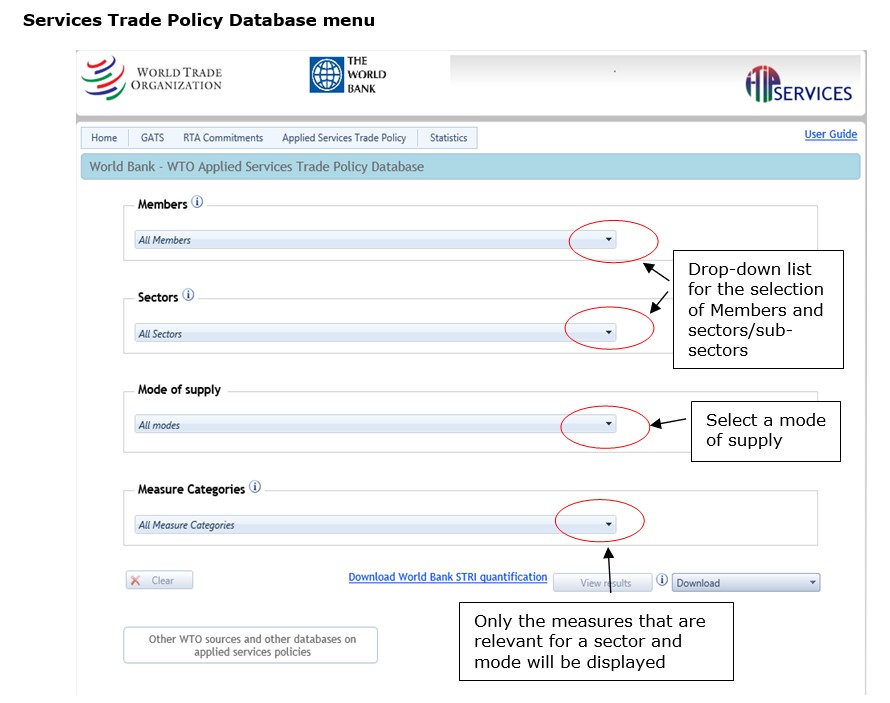
A drop-down list permits the selection of one or many of the economies currently covered in this module.
It is also possible to limit the search to one or more of the service subsectors covered. The drop- down list for the 'sectors' search criteria also permits to select horizontal measures separately.
From the selection page, the user also has the possibility to limit its search to certain mode(s) of supply(6) and measure categories. A selection can be made starting from any of the drop-down menus. The menus “Sectors”, “Mode of Supply” and “Measure categories” are linked: only the measures that are relevant for a sector — and mode — will be displayed for possible selection options. For instance, if the mode of supply is selected first, say cross-border, only measures applicable to mode 1 will become active in the measure categories menu.
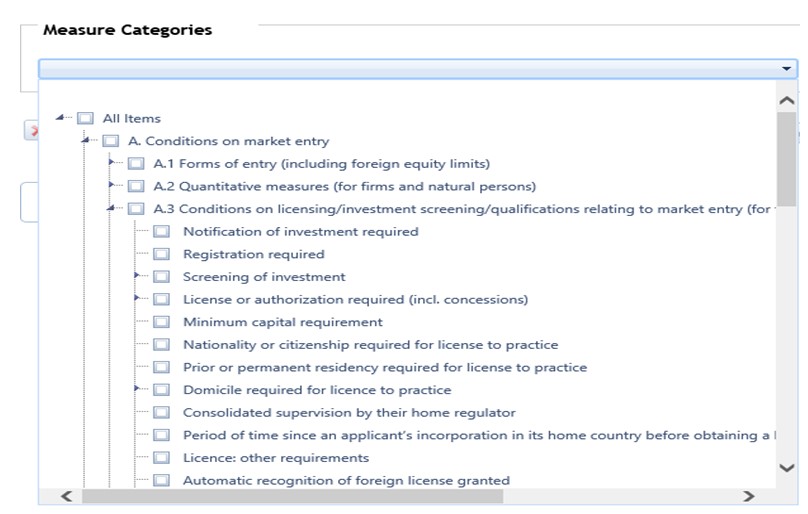
The results of the selection defined by the user can be viewed on the screen (“View results”), or downloaded directly in Excel, pdf or csv format (“Download”). An option to download the entire dataset is also proposed in the “Download” menu. These are shown at the bottom of the right-hand side of the selection page. A description of the Excel and csv files is provided in section 5.2.2.4. A link to the World Bank Services Trade Restrictions Index (STRI) is provided on the selection page as well (“download World Bank STRI quantification”).(7)
The search criteria entered appear at the bottom of the screen (in yellow). To delete the search criteria entered, click on the red “X” next to the drop-down lists or on the “X clear” button (to delete all search criteria).
Finally, from the Services Trade Policy Database module, it is possible to access other useful sources of information on applied services policies (e.g. WTO monitoring reports, WTO trade policy reviews).
5.2.2 Overview of selection results
5.2.2.1 Main features
The results of the selection are first presented in an overview page to provide the user with a general presentation of results. Answers are limited to “yes”, “no”, “N/A”, or a number. “Yes” and “no” responses are straightforward, indicating the existence or non-existence of the measure, while responses with numbers may indicate percentages (e.g. limits on foreign equity ownership) or a number (e.g. number of days to process licence applications). N/A is used either because the information is not available or is not applicable. The interface gives the possibility to access more details (comments, legal basis, information on source) for each individual measure by hovering or by clicking on the hyperlinks.
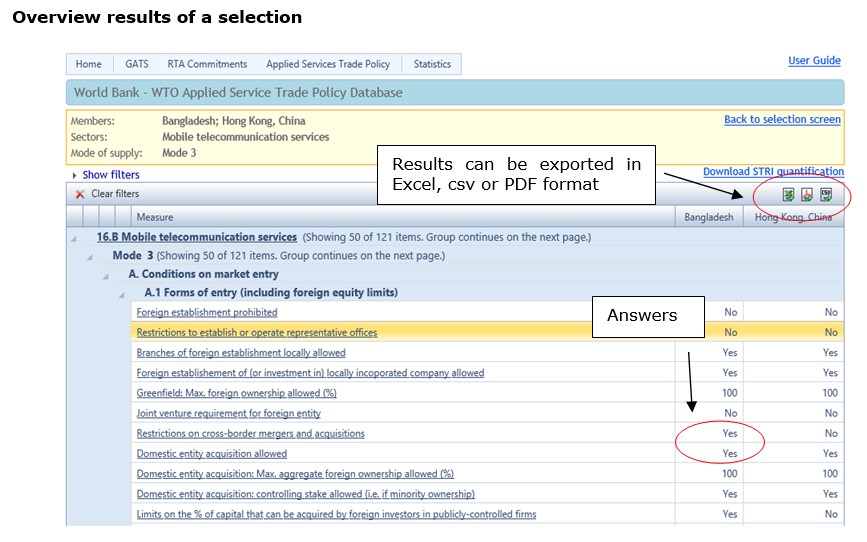
Only results for up to 3 economies can be displayed on the screen, but if more than 3 have been selected, the full selection is downloadable in Excel and csv. The pdf is also limited to 3 economies.
The user can navigate to different pages of the selection results by using the relevant page number links at the bottom of the table. The number of records to be displayed on a single page (10, 20, 50, 100, All records) may be defined by the user by clicking on the drop-down menu on “page size”. The print function of the browser can be used to print the results.
5.2.2.2 Filters
The database offers the possibility to filter the search results by subsector, mode of and measure category. This makes it possible to view the results in the overview for only one of the subsectors, modes of supply or measure categories at a time. To do so, click on “show filters” (at the top of the table), and make your selection using the respective drop-down lists.

To return to a full view of the search results, click on “X Clear filters”.
5.2.2.3 Detailed view of the results
While the selection results are initially presented in an abbreviated and succinct manner to provide the user with a general picture of applied policies, the database allows users to view the full details of the results. The interface gives the possibility to access more details by hovering or by clicking on the hyperlinks. By hovering the user only obtains summarized information (year of information, comments). By clicking on the hyperlinks, the user can view the mode concerned, the measure and associated response, eventual comments, information on the source, the year for which the information was collected and who collected it.
Only the results corresponding to the 3 economies displayed on the overview screen can be viewed.
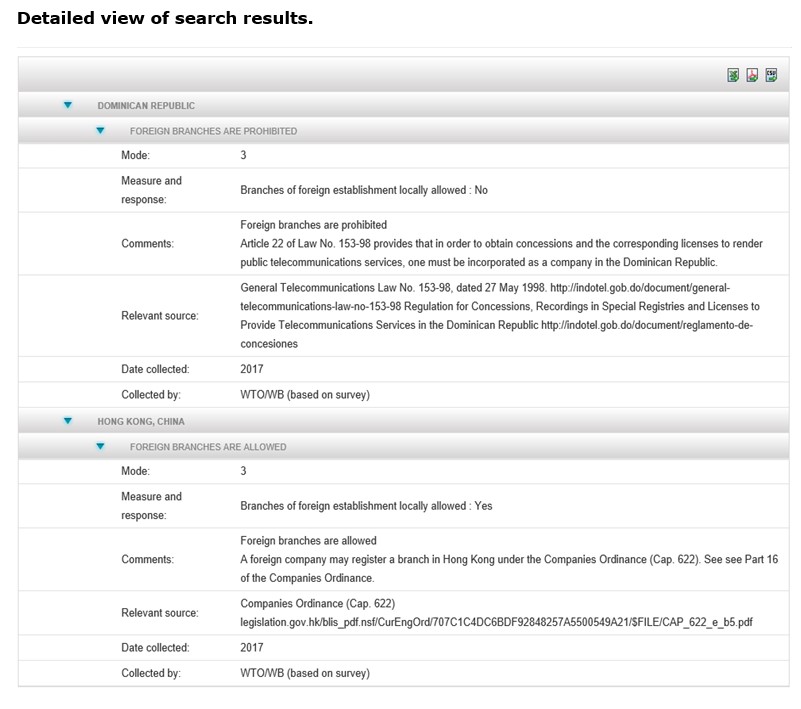
5.2.2.4 Export to Excel, csv or PDF format
All results, like the overview results or the detailed view, can also be exported to Excel, PDF or csv format by clicking on the relevant icon on the top right-hand side of the table or the window. Note that there are download options on the selection page (including an option to download the entire dataset in csv format).
The information in the Excel and PDF downloads is organized as follows:
- Economy
- Sector
- Mode of supply
- Category of measures
- Subcategory
- Measure
- Response
- Comments
- Relevant legal basis
- Year of data collection
- Agency responsible for original collection

The results of the STRI quantification can also be downloaded from the results page. By clicking on “Download World Bank STRI quantification”, a zip folder containing three Excel workbooks and a ReadMe text file will be saved to the computer. Each Excel workbook contains a different set of STRIs that are shortly explained below. For more detailed information, the user should refer to the help file “_ReadMeFirst.txt” and the respective “README” sheets contained in each workbook.
- “01_2016_WB_STRI.xlsx” includes the complete 2016 World Bank STRIs based on the improvements in the STRI methodology introduced in the Guide to the STPD (Borchert et al., 2019) (8).
- “02_200811_2016_comparable_WB_STRI.xlsx” includes the STRIs for both 2008-11 and 2016 that can be compared to each other using the improved 2019 STRI methodology (Borchert et al., 2019) (8). A comparison of policy restrictiveness over time requires different sets of STRIs because of necessary adjustments to allow for an intertemporal analysis. This causes the STRIs included in this file to differ from the STRIs contained in “01_2016_WB_STRI.xslx”. Detailed information on the adjustments are provided in “_ReadMeFirst.txt” and the “README” sheet in the Excel workbook. The comparable World Bank STRIs for 2008-11 and 2016 using the improved 2019 methodology were produced in cooperation with the WTO Secretariat.
- “03_OLD_200811_WB_STRI.xlsx” includes the results of the quantification of services trade policies in 2008-11, i.e. the original STRIs as compiled and published by the World Bank in 2012. These STRIs were constructed based on the methodology at the time of publication in 2012 and are not comparable with the STRI datasets available in “01_2016_WB_STRI.xlsx” and “02_200811_2016_comparable_WB_STRI.xlsx”. For more information on the 2008-11 World Bank STRIs compiled and published in 2012, please refer to https://www.worldbank.org/en/research/brief/services-trade-restrictions-database
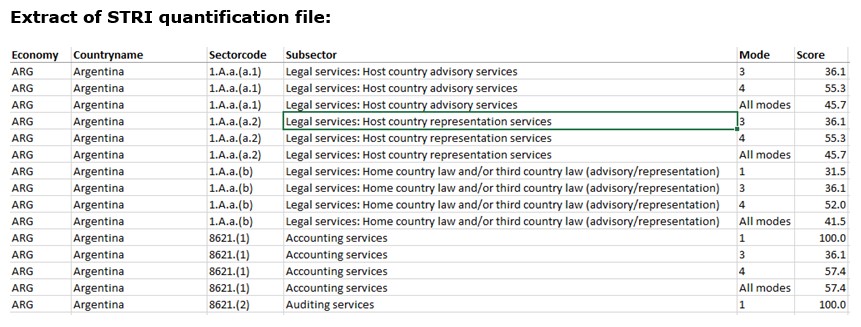
5.2.3 Other sources of information on applied services policies
The main page of the “Services Trade Policy Database” module provides a link to “Other WTO sources and other databases on applied services policies” (white button at the bottom of the page, left-hand side, turning yellow when hovering over it).
This link takes the user to a sub-module within the Applied Services Trade Policy module containing applied services measures from other WTO sources (e.g. Trade Policy Reviews, Trade Monitoring reports, GATS notifications), as well as publicly available information. The page is identified by a large violet banner.
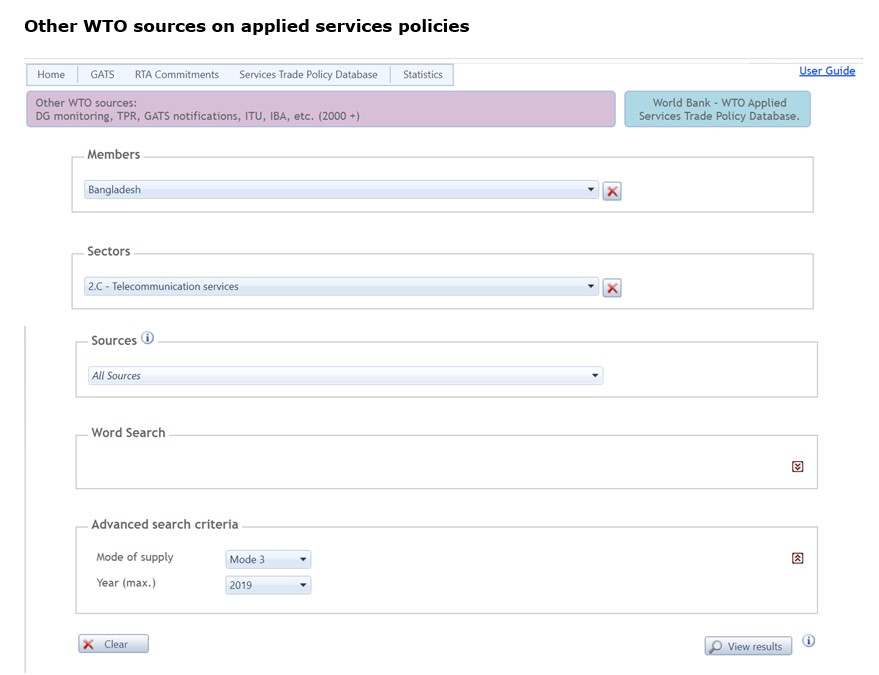
While not as systematic as the information contained in the main Services Trade Policy Database module, this sub-module contains information — albeit partial — on other sectors and economies. In this sub-module, the services have been classified at the 2-digit level of the Services Sectoral Classification List (W/120) (with the exception of legal and accounting, auditing and bookkeeping services.
Information can be selected by economy (as well as groupings), sector/subsector and sources. Modes of supply can be filtered, as well as the latest year for which the user wants to view information for. Finally, a word facility is proposed.
From the selection page and overview of results page it is possible to return to the main component of the Services Trade policy Database module (keeping in mind that in the latter, the selection of economies and sectors is reduced).
The results are presented in the overview of results page in text form. The titles used to identify the types of measures (‘measures titles’) are summaries of the measures identified in these alternative sources.
Results are ordered by economy and then by sector/subsector. Results can be filtered for economies, sectors/subsectors as well as other filtering options.
By clicking on the hyperlinks it is possible to view more detailed information.
Finally, the print function of the browser can be used to print the results, and information can be exported in Excel or PDF format by clicking on the relevant icon on the top right-hand side of the table or window.
back to top
6. Statistics Module
The Services Statistics module accompanies the GATS, RTA and Applied regimes modules by providing relevant trade in services and related statistics. Descriptions of the various statistics presented in this module are provided in the sections below.
6.1 Selection page
After clicking on the ‘'Statistics’ icon on the I-TIP Services portal, the selection screen appears, and offers the possibility to search across relevant trade in services sectors and related statistics by selecting economy and W/120 services sector/subsector. The dropdown lists to select one or many economies or/and Sectors/subsectors Sections 2.1.2 and 2.1.3 provide more information. To view data for total services, select “All sectors” in the ‘Sector’ search criteria.

The search criteria entered will appear at the bottom of the screen (in yellow).
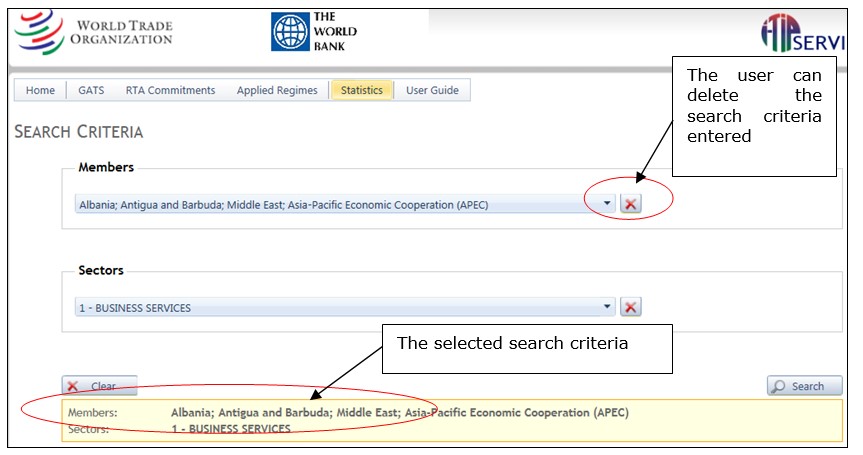
It is also possible to limit the search to one or many services sectors. The drop down list for the ‘Sector’ search criteria permits to select one or many of the 12 W/120 sector groups as well as one or many of the numerous sub-sectors.
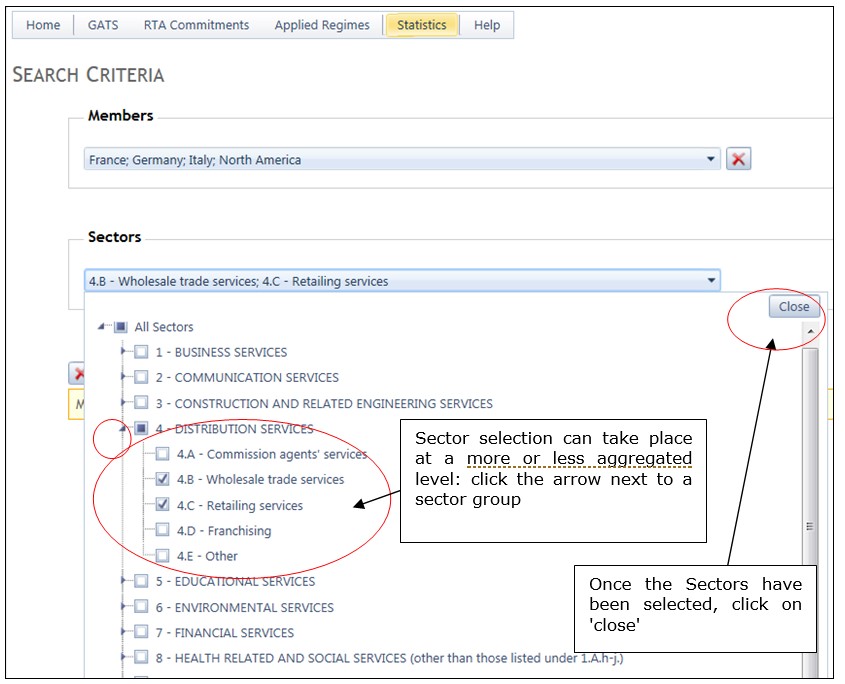
Once all desired search criteria have been selected and the user is ready to see the results, press the ‘search’ icon.
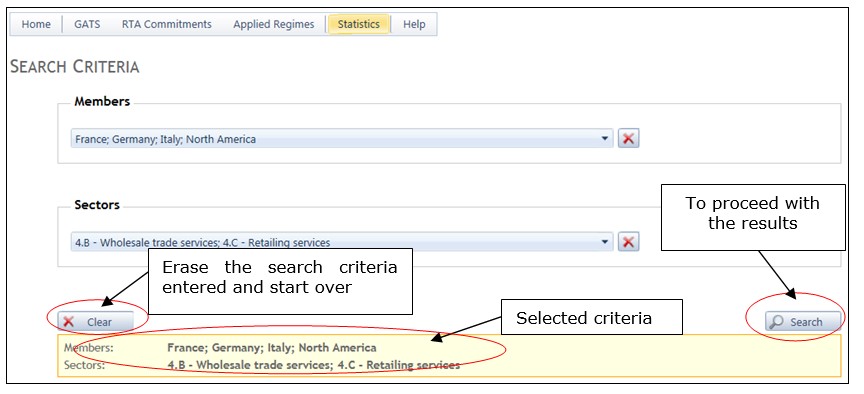
To erase the search criteria entered and start over, press the ‘clear’' button.
6.2 Overview of selection results
6.2.1 Main features
After entering the search criteria and submitting his choice, the user is sent to the ‘search results’ page. Below, an example of search results for Austria — Business services.
The menu bar at the top of this ‘search results’ page consists of the four different modules in the database. The module currently used is highlighted. The same selection remains when the user switches to any other module.
The search criteria entered by the user is depicted below the menu bar. Clicking on ‘modify selection’ sends the user back to the ‘selection criteria’ page, where new criteria can be entered to perform a new search.
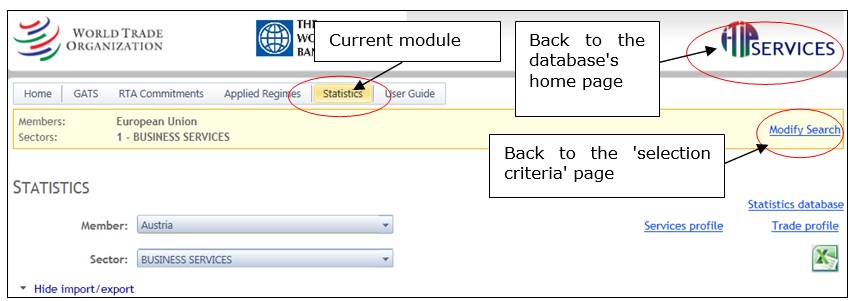
Useful links to the WTO statistical database and Trade and Services profiles can be found in this part of the page, as well as an Excel export tool. The trade and services profiles are shown for the economy selected.
The search result page for the statistics module provides detailed information on four main groups of statistics: trade in services imports/ exports (balance of payments based), foreign affiliates statistics (FATS), other indicators (foreign direct investment (FDI), value added & employment), and services specific indicators. The page also provides information on data sources.
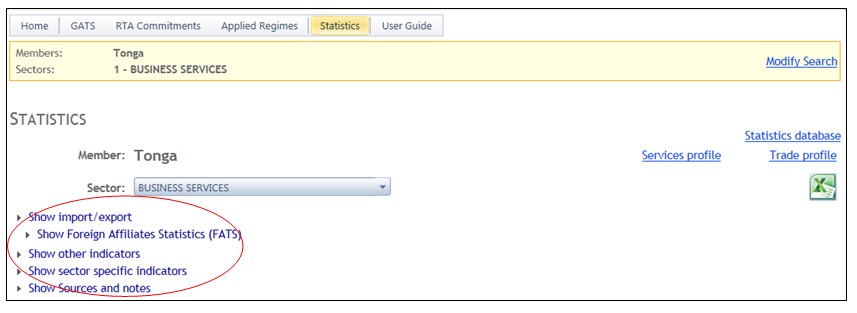
The search results are presented in the form of tables for each group of statistics for each economy and W/120 sector selected.
The users are recommended to check the information icon ![]() to obtain details on the definitions and coverage of the statistics used.
to obtain details on the definitions and coverage of the statistics used.
If data are not available at the most detailed level, statistics shown correspond to the nearest aggregate.
The following sub-sections explain the different components of the Statistics module page.
6.2.2 Sectoral Classifications in the Statistical Module
When working with the statistical tables on the search results overview page, it is important to understand the sector classification underlying each particular group of statistics.
The W/120 is the services negotiating list which groups together 12 main service sectors sub-divided into a total of some 160 sub sectors.(9) W/120 is mainly used in a WTO context, and it is the common sector classification used in all I-TIP modules. The I-TIP statistical module allows searching by W/120 service sectors and sub-sectors.
The Extended Balance of Payments Services Classification (EBOPS) is primarily a product-based classification used to classify statistics on international trade in services between residents and non-residents (i.e. balance of payments basis). EBOPS is built upon the BPM6 classification of services which identifies 12 main service categories and breaks them down into a list of standard and supplementary components. EBOPS consists of a further breakdown of these components into more detailed sub-items. It is available at http://unstats.un.org/unsd/tradekb/Knowledgebase/MSITS-2010
Although categories based on W/120 and EBOPS classifications are related, a one-to-one correspondence is not always possible.(10)
It is also more difficult to establish correspondence between the two classification systems in the areas which focus on the mode of consumption of goods and services or the status of the transactor, rather than on the type of product consumed, such as travel or construction. For example, EBOPS component SD ‘Travel’ (and its constituent parts) cannot be fully described in terms of W/120 since travellers may consume a wide range of goods and services.
Statistical tables for Import/Export of services on the I-TIP search result page contain the product categories according to EBOPS classification.
Another classification system, namely the International Standard Industrial Classification of All Economic Activities, Revision 3 or 4 (ISIC, Rev.3 or 4)(11) is used for other groups of data presented, such as Foreign Affiliates Statistics (FATS), Foreign Direct Investment data (FDI) and data on value added and employment. Unlike EBOPS which classifies trade in services based on service products, ISIC is an activity classification, i.e. all of the data for a given enterprise are classified according to its primary activity, that is, the single activity for which its sales (or another key variable such as employment) are largest. For example, the total output recorded under legal activities refers to the total sales of law firms rather than the actual supply of legal services. Some enterprises which are not classified as law firms also offer legal services as a secondary activity; however this production is not included in legal activities. Further, the output of legal activities might include some of law firms' output resulting from secondary activities, such as, for instance, providing financial advisory services.
This is why this module presents statistics according to the item(s) that most closely correspond to W/120 category selected in statistical classifications. For example, for the trade in services statistics shown (balance of payments basis), the user may be provided with an option to further choose the categories based on the Extended Balance of Payments Services Classification (EBOPS 2010) if there is more than one correspondence with the W/120 sector.
Here is an example of a complete item correspondence between W/120 and EBOPS classifications: sub-sector ‘Research and development services’ of the sector ‘Business services’ listed in W/120 fully corresponds with ‘Research and development’ group from EBOPS.
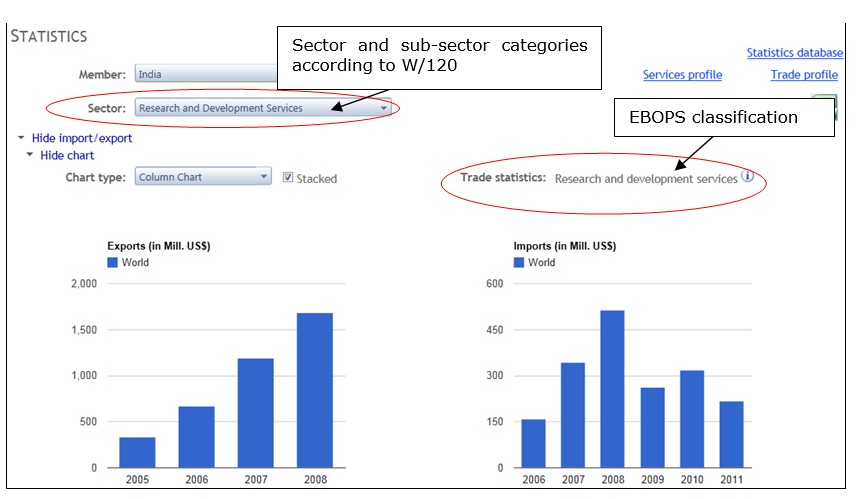
As indicated above, some items of the W/120 correspond to more than one EBOPS categories. The example below demonstrates that the sector ‘Real Estate Services’ listed in the W/120 corresponds to two EBOPS items ‘Operational leasing services’ and ‘Other business services n.i.e.’. By choosing different EBOPS categories, the user changes only the chart presented on the search result page. The table of imports/exports provide data on both EBOPS categories separately.
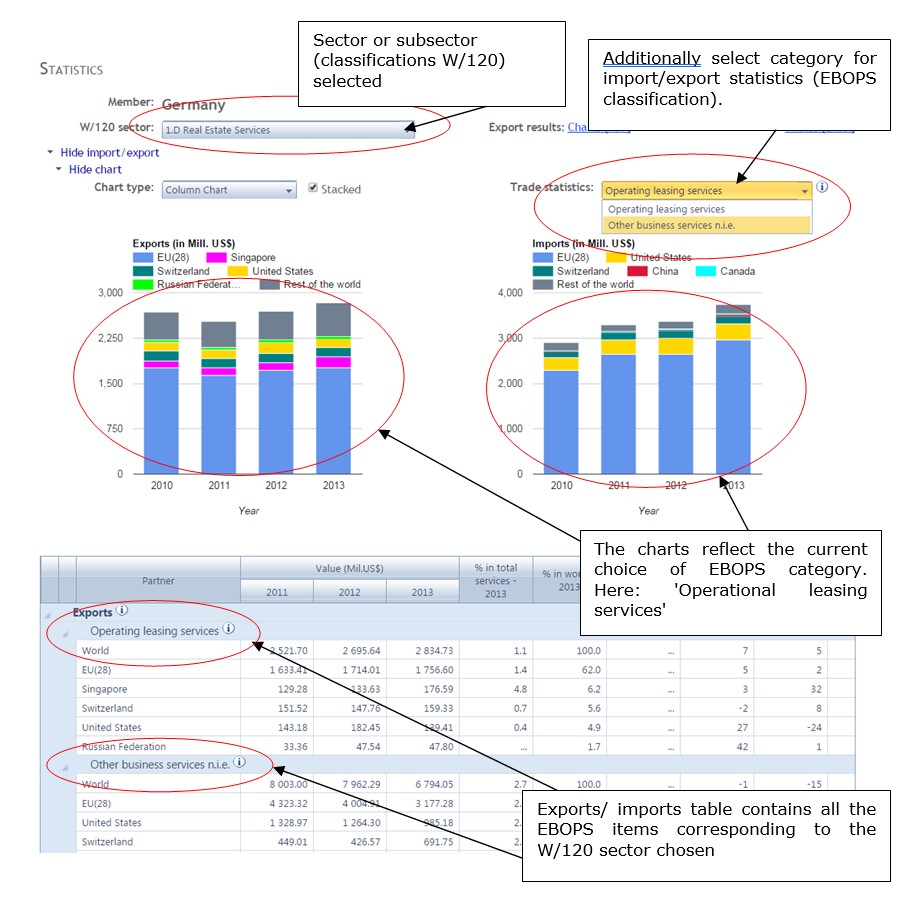
6.2.3 Detailed view of selection results
6.2.3.1 Import/ Export (balance of payments basis)
The data on exports (credits) and imports (debits) of commercial services are broken down into components according to EBOPS which provides a basis for the measurement of trade in services in the conventional sense. For the users' convenience, imports and exports are presented in form of a chart and a table for each economy and sector or sub-sector.(12)
The chart tool enables the users to choose different chart types and shows import/export by trading partners of the economy (if data are available).
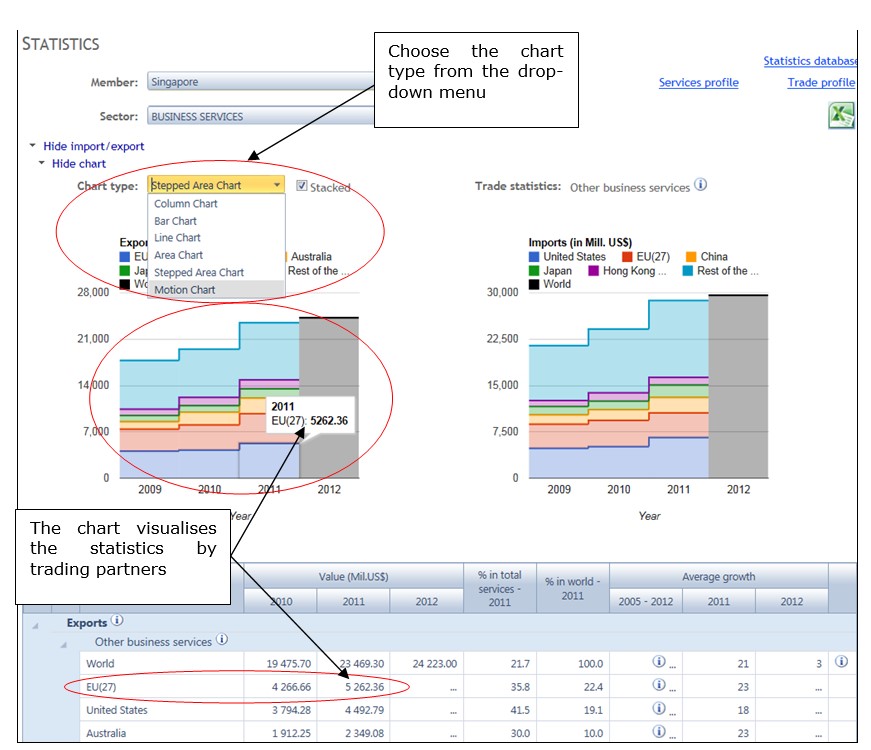
The table Import/Export summarizes the trade statistics on selected EBOPS items for a selected economy with possibility of data disaggregation by trading partners. The following statistics are presented in the table: export/import values (in mil. US dollars) for the last three years for which data are available; ‘% in total services’ provides data on the share of the service sector in the economy's total trade in commercial services with the partner identified; ‘'% in world’ shows the share of partners in the reporter's total trade for the given EBOPS service item; finally, ‘Average growth’ columns contain data on the average annual growth of the exports/imports over 2005 and growth rates over previous years.
6.2.3.2 Foreign Affiliates Statistics (FATS)
The international delivery of a number of services requires certain physical proximity between producers and consumers, which can often only be achieved through a commercial presence abroad, i.e. the establishment of foreign affiliates. The framework of Foreign Affiliates Statistics (FATS) provides for the compilation of a number of indicators on the operations of foreign-controlled enterprises.(13) Data on the operations of both domestic enterprises controlled by foreign investors (inward FATS), and affiliates abroad controlled by residents (outward FATS) are shown. (14) The following indicators describe the operations of foreign affiliates: sales (turnover) and/or output, employment, value added, exports and imports of goods and services, and number of enterprises.
The module provides statistics on sales/turnover(15), number of enterprises and number of employees of foreign affiliates. The statistical module presents FATS sales/turnover, number of enterprises and number of employees broken down by primary industrial activity of the affiliates.(16) The activity classification for FATS variables is based either on the International Standard Industrial Classification of All Economic Activities, Revision 3 or 4 (ISIC Rev.3 or 4).(17) FATS table for Czech Republic, sector ‘Business services’ listed in W/120 is presented below (in this example corresponding to ISIC Rev.3 categories ‘Administrative and support activities’, ‘Information and communication’, and ‘Professional, scientific and technical activities’):
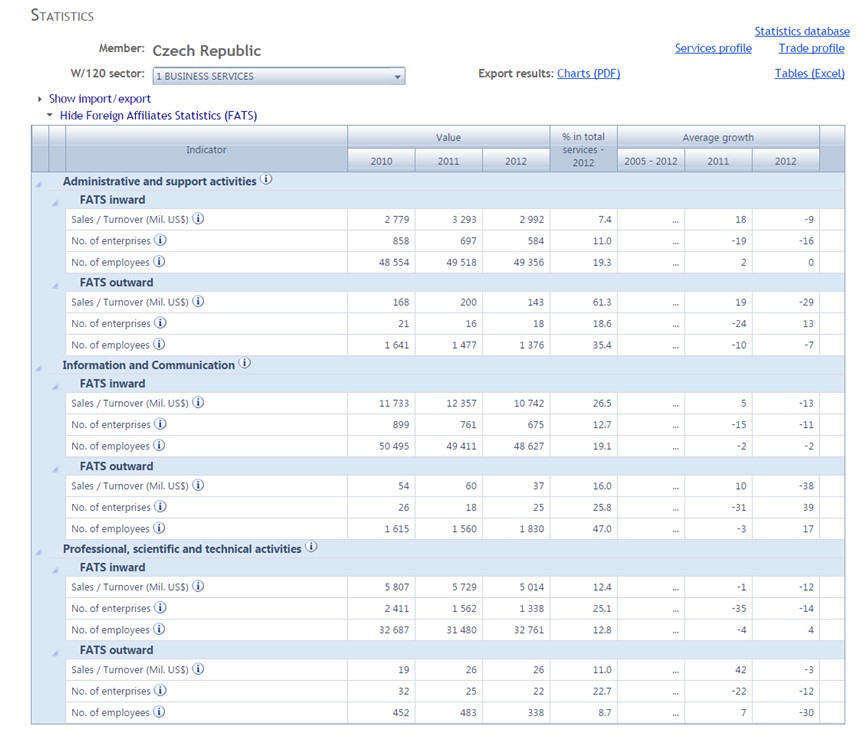
When analysing FATS data broken down by activity, one needs to keep in mind that these statistics might give an approximation, but not a precise measure, of the activity itself. It is caused by the fact that FATS include all the enterprises undertaking a selected activity, even those for which this activity is secondary. For example the statistics of a firm specializing on financial services and providing legal services as its secondary activity will be included in FATS for financial intermediation services.
6.2.3.3 Other Indicators
6.2.3.3.1 Foreign Direct Investment (FDI) Statistics
FDI statistics are concerned with international economic relations(18) between direct investors and the enterprises which receive the investment (the direct investment enterprises).(19) They measure financial transactions between them, and related income and investment position. FDI statistics are considered as an important supplementary set of indicators to FATS variables. The population of firms covered by FDI is bigger than that of FATS as the former covers all relationships where a direct investor controls more than 10% of the voting power in a direct investment enterprise (i.e. influence), whereas the latter only covers those which are controlled by more than 50 % (i.e. control). FDI statistics are distinguished between outward and inward FDI.
FDI data can be also presented in terms of positions and transactions. FDI financial transactions refer to those cross-border transactions which qualify as direct investments recorded during the reference period (year, quarter, or month). Negative values in transactions may indicate disinvestment in assets or discharges of liabilities. FDI positions represent the value of the stock of FDI held at the end of the year.
The module provides FDI data on the basis of the economic activity of the direct investment enterprise according to the International Standard Industrial Classification of All Economic Activities, Revision 3 or 4 (ISIC Rev.3 or 4).(20) Below is an example of the FDI statistics table for Mauritius, for the sector ‘Tourism and Travel Related Services’ listed in W/120 (in this example corresponding to ISIC Rev.4 category ‘Accommodation and food services’):

6.2.3.3.2 Value Added and Employment
Value added and employment indicators are important statistics reflecting economic activity in particular industries or sectors.(21)
The module provides value added and employment statistics on the basis of the economic activity in accordance with the International Standard Industrial Classification of All Economic Activities, Revision 3 or 4 (ISIC Rev.3 or 4).(22) Here is an example of the table ‘Value Added and Employment’ for Chile, sector ‘Financial Services’ listed in W/120 (in this example corresponding to ISIC, Rev.3 category ‘Financial Intermediation’):

6.2.3.3.3 Sector-specific indicators
I-TIP Services also proposes a large amount of statistical data specific to different economic sectors. The module presents a selection of sector-specific indicators that are broadly available across economies. These indicators supplement main economic statistics with data unique to each service sector. An example of sector specific indicators for ‘Ghana — Communication services’ is presented below.

6.2.4 Additional functions
6.2.4.1 Export to Excel
Statistical tables from the search results overview page can be exported to Excel by clicking on the relevant icon on the right hand side of the page.
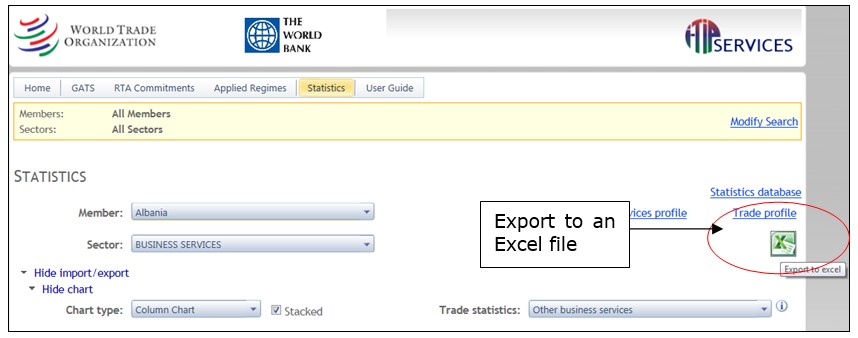
The data will be exported to an Excel file containing the different groups of statistics on separate sheets:
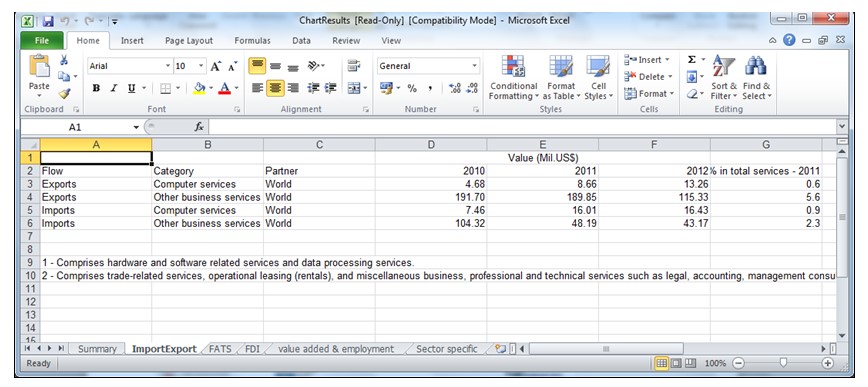
6.2.4.2 Useful links
Links to the WTO statistics database, the service profiles as well as the trade profiles of the economies are located on the right hand side of the result overview page.
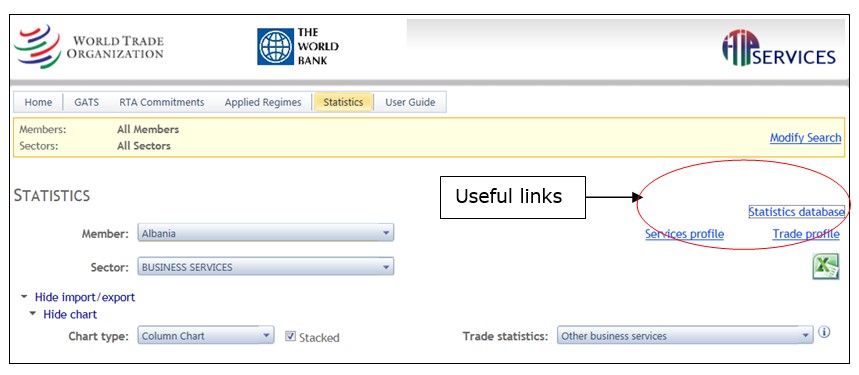
6.2.4.3 Information icons
The module contains a number of footnotes presented in the form of information icons. They provide the users with additional information regarding definitions of indicators, sector classification used, data range (year coverage) and availability, as well as relevant precisions.

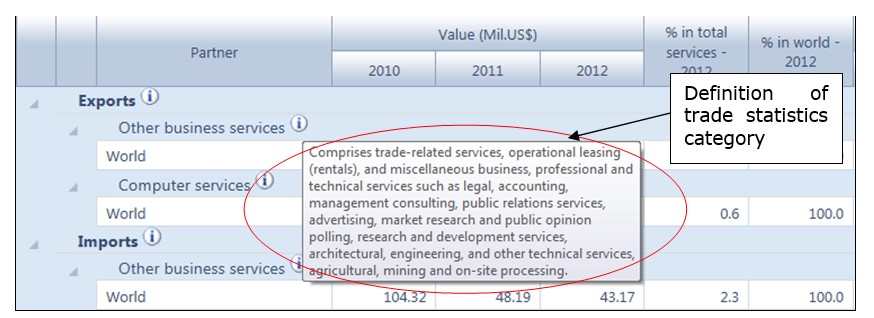


Notes:
1.Document MTN.GNS/W/120, dated 10 July 1991. Thereafter referred to as “W/120”. Back to text
2. Document S/L/92, dated 28 March 2001. Back to text
3. For financial services the list presented in Article 5 of the GATS Annex on Financial Services is used. Back to text
4. If there are no specific commitments to display for the Member(s) and sector(s) selected from the selection criteria page (e.g., “Canada” and “2.D — Audiovisual services”), the results page will indicate “No records to display”. Back to text
5. Other obligations for which reservations can be undertaken in this type of RTAs generally include MFN treatment, local presence, senior management and board of directors, and performance requirements. Back to text
6. The modes of supply are defined as in the GATS. Back to text
7. The STRI has been developed by the World Bank, in co-operation with the WTO. Back to text
8. Borchert, Gootiiz, Magdeleine, Marchetti, Mattoo, Rubio and Shannon (2019) — “Applied Services Trade Policy: A Guide to the Services Trade Policy Database and Services Trade Restrictions Index”, WTO Staff Working Paper (ERSD-2019-14) Back to text
9. Section 2.1.2 ‘Sectoral Classification’ provides information on classifications used in I-TIP Services. Back to text
10. The tables of correspondence between EBOPS and W/120 can be found here: http://unstats.un.org/unsd/tradekb/Attachment356.aspx Back to text
11. The fourth revision of ISIC has replaced the third revision of the classification since its official release in August, 2008. However, some Members still report their trade statistics according ISIC, Rev.3. Back to text
12. For more information on data sectoral classifications as well as the detailed explanation of data presentation, please consult the section ‘Sectoral classifications in the Statistical Module’. Back to text
13. Foreign-controlled enterprise is defined as the one where a foreign investor (associated group of investors acting in concert is considered as a single investor) owns more than 50 % of voting power. FATS reflect all operations of the affiliates concerned rather than being prorated according to the controlling share of the foreign parent firms.. Back to text
14. More information on FATS can be found here: http://unstats.un.org/unsd/tradeserv/TFSITS/manual.htm Back to text
15. Although output would be a preferred measure, the module presents the variable sales/turnover as data on foreign affiliates' output are available for a small number of Members. In the few cases where no data on sales/turnover are available, data on output are shown. Information icons provide relevant notes for such cases. Back to text
16. Some Members publish data on products of their foreign affiliates but for the sake of cross-country comparability the statistical module still presents FATS by primary industrial activity. Back to text
17. Section ‘Sectoral classifications in the Statistical module’ of this user guide provides a more detailed discussion of the classifications used, including ISIC. Back to text
18. For statistical purposes, FDI relationships are defined by the ownership of at least 10% of a foreign enterprise's voting power. Back to text
19. More information on FDI can be found here: http://unstats.un.org/unsd/tradeserv/TFSITS/manual.htm Back to text
20. The section ‘Sectoral classifications in the Statistical module’ of this user guide provides a more detailed discussion of the classifications used, including ISIC. Back to text
21. Value added is the value of output less the value of intermediate consumption. (OECD Glossary of Statistical Terms: http://stats.oecd.org/glossary/detail.asp?ID=1184) Back to text
22. The section ‘Sectoral classifications in the Statistical module’ of this user guide provides a more detailed discussion of the classifications used, including ISIC. Back to text
